#spice ersatz
Explore tagged Tumblr posts
Text
Random Assortment of Ghibli’s Howl’s Moving Castle Thoughts
Because I rewatched it today for the first time in many years and it’s one of those miraculous works that not only remaine as magical as I remembered it through childhood eyes, but if anything was even more magical as an adult and in more complex ways. I’ve finally got words for at least some of the things I was processing only subconsciously as a kid, so here we go.
- The sneaky underlying theme of deeply flawed mother figures in this movie. Drives me nuts. The narrative doesn’t go out of its way to condemn these characters, it takes a characteristically phlegmatic nonjudgemental view of them, but it feels like this is low-key a stealth Mommy Issues story. (Making it go 🤝 with Dragon Age 2 in my head lol) Sophie’s mother does not seem to be consciously malicious but is intensely smotheringly self-absorbed and immature to the point where it has clearly been neglectful, and on the other side of the ‘Overly Permissive/Neglectful to Overly Authoritarian/Controlling’ scale of shitty parenting Suliman is controlling and invasive and heedless of boundaries. (Notice that her real complaint about Howl entering the contract with Calcifer and thus losing his heart seems to be that it means she can no longer control him and his grasp on magic, more than actual worry for him as a person. Her presence in his life is largely, ironically, paternalistic. She even frames it as something he blundered into incompetently — phrasing as him having had his heart stolen, rather than the mutual agreement we see Howl and Calcifer make even if they couldn’t know all the consequences it would have.) In the end Sophie breaks the circle by managing to be an engaged and responsive mother figure to Markl and making an actual home with the people closest to her.
Interestingly Howl at his worst seems to be much more like Sophie’s mother than like Suliman — he leaves Markl to handle things he really shouldn’t have to alone all the time and is noted to barely be home anyway, in the beginning especially he’s flighty and vivacious and evasive (not to mention aggressively blond haha) in some of the same patterns we see her mom exhibit. Since Lettie is quite like their mother in terms of looks and sociability, we might infer that Sophie takes more after their father (including in choice of spouse lol). But crucially when the chips are down Howl is ready to protect Sophie and their home with his life rather than abandon her, in sharp contrast with her mother. I like that the movie doesn’t vilify Sophie’s mom for what she does, as such, it’s a pretty impossible position to be in for anyone… but it is just an extension of what she’s apparently been doing for a long time anyway, privileging other parts of her life and her own comfort over her daughter’s wellbeing and happiness. (Adds a certain spice and heartache to how scared Sophie is that Howl is going to leave them, too. And her fear that it would be because she’s fundamentally not good enough, beautiful enough, clever enough for anyone to choose her and stay with her. Ooof. Girl he’s been looking for you everywhere girl he thinks you’re the most beautiful thing in the world girl it’ll be okay)
- Relatedly: the unspeakably sinister vibes and implications of Suliman’s fucking… army of little Ersatz Howl page boys. When I was younger I sort of bought that he was just being a coward in refusing to go back, but honestly looking at all those kids with smiling empty eyes like painted marbles — you know what maybe it was good he got out of there when he did and in whatever way he could, huh. I don’t feel like there were wonderful things ahead here. Between that and the Witch of the Waste — who must have been much, much older than him when they seem to have sort of had a thing, since he seems to be like… mid-twenties-ish? at the time of the movie — there’s some really uncomfortable subtext going on if you want to read into it that way. I don’t think it’s the only way to read it by any means, but there’s something icky and clandestine sticking to Suliman’s whole deal that makes some form of grooming feel potentially relevant, especially taken along with the shame and fear that seems to cling to Howl around it and the recurring symbolism of him being stuck at a child state beneath it all — he slipped away from Suliman one day but never really grew up. (I’ll readily admit this is some fully Vibes based ramblings on my part, so YMMV on how convincingly you find this present in the text vs. how much is conjecture in my overthinking overheating noggin lmao)
- The fact that the first thing that allows Sophie to heal is to get to be angry — to finally get to say ‘this is all such absolute fucking bullshit *aggressively scrubs all the shit away about it*’. So much of her arc is about reclaiming the full spectrum of her emotions instead of having to make herself small, to prioritize her own inner experience and expressiveness above the need to be acceptable or pleasing to someone else's gaze. It’s not doing quite the same thing as the book in this regard (which if memory serves does more complex work around societal dynamics around gender and sexuality and aging vs. the more internal personal approach the film takes), but what it is doing is very interesting in its own right. The castle being a space (a home!!!) where all the inhabitants can eventually express themselves freely, including Howl dropping the uncannily imperturbable smiling facade to show the sad wet pathetic drama queen beneath (deeply affectionate) and Markl just getting to be a kid running around having fun. And Sophie makes that home for everyone possible by being herself unfiltered for the first time in her life. What the fuck I’m not crying don’t look at me —
- The little one-room cottage in the fields being the forerunner to the castle…
- Something so pleasing about the irony that Howl is said to eat hearts when really he seems to have basically had to tear his own heart out and set it on fire to keep it safe. And then after people have tried to get their hands on it to possess it (the Witch) or dictate how he uses it and who he gives it to (Suliman) for the whole movie, Sophie gives it back to him without a thought at the end; it’s more important to her for him to be whole than to own his heart. Hmnngh. (also so funny that the first thing he does upon waking up is plaintively whining about it fhdasj. Yeah having feelings again can take a person like that)
- Howl’s bad dye job freakout is still very funny and silly, of course, never change you giant drama queen slime the place down, but there’s something about the fact that he’s apparently been dyeing his hair the colour Suliman seems to favor/uses to mark ‘her people’ all this time even when he hasn’t been able to face her, especially since the flashback shows black is his natural hair colour, and how badly it freaks him out to not meet that standard anymore… Huh. Hm.Hah.
(This time I actually wondered to myself if part of the reason he made the deal with Calcifer was to be able to get away from her and the plans she had for his life (and that he clearly would have hated, if their fundamental philosophical disagreement about warfare is any indication!). I think it says some very sad things that his happiest childhood memory is of a secret place where he got to be entirely alone because it was the only place he felt safe. Howl’s Moving Giant Coping Mechanism Metaphor. You see the castle is the Flight response made. Well not flesh. Timber, I guess. The Flight response made timber. In this essay I will etc.)
- It hurts me that Howl brings Sophie’s old bedroom into the castle. He wanted so badly to make her happy and he seems to assume that because his memory of childhood solitude is a… if not happy then comforting thing to him, it would be for her too. But to her that’s just a reminder of the stagnancy and loneliness and… indignity? of her life before, and makes her feel like he’s treating her like a housekeeper, relegating her to that tiny room all over again, unwanted and ignored. Augh. At least she seems to understand what he meant to do for her when he shows her the meadow, though, and he doesn’t stop trying to communicate it to her even though his gesture didn’t land the way he’d hoped at first. This movie is so quietly kind about people trying to learn how to understand and love each other. Everyone is allowed to stay at the castle in all their imperfections, even the Witch.
- Something something the Witch curses Sophie with not being able to tell anyone what’s happened to her… and in the end that doesn’t even really matter because the people around her either grow to understand without having to be told by actually paying attention to her (like Howl) or just accept her exactly as she is anyway, age yo-yoing and all, no questions asked (like Markl). And in the same way Sophie immediately recognizes Howl in his monster form and isn’t afraid of him even when he tells her it’s too late. Suliman warning her about ‘what he really is’ and Sophie immediately hugging him in his full monster form because he came home and that’s all that matters to her. Howl thinks her white hair is the most beautiful thing in the world and worth coming back to the world fully for. Sobbing.
- The implication that part of the reason Calcifer wants out of the contract (other than just being stuck in the hearth of a place slowly falling into depressing disrepair and neglect around him) is that he’s genuinely terrified of what Howl is doing to himself. There’s something kind of sad and very funny about that. What if you went into a deal with a demon and the demon had to keep telling you ‘uh. Uh bro that’s kind of fucked up you know that right. Hey are you listening to me you’re molting monster feathers onto the carpet Sophie is gonna LOSE IT and don’t come crying to me when she does’. I wonder what would have happened to Howl’s heart if he turned completely — it seems that their contract has kept it safe and unchanged in every other way, if frozen in time, so presumably it would just… keep going the same way? (Calcifer telling Sophie that ‘it’s still the heart of a child’ got me so bad this time around. Bawling all over the place haha.) The idea of being stuck burning around a homeless heart forever is — well Calcifer I guess I get where you’re coming from here
- Of interest only to a very few people, I suppose, but the Norwegian dub of this movie fucking rules, I’m glad to find my childhood self was right about that. Calcifer is so cute in it it almost makes me dizzy sometimes, Aksel Hennie went ham on this one. Also an incredibly calming and charming performance for Howl — whenever I hear the English dub I just start laughing b/c like uh okay that’s Batman, takes me right out every time, that is not my lil guy fhsakjd. (I suspect his characterization is a bit different and softer in Norwegian too, just from the differences in translation I’ve seen?)
- The first time Howl takes Sophie flying he holds her hand through it the entire time and guides her, the second time he takes her flying he lets her steer the flying machine for a while under his supervision before he goes off to make the distraction (there’s something so sweet about it as much as he’s being a little shit about it, honestly, he believes in her in such a quiet undramatic way even as she’s freaking out), and then after walking away from Howl’s childhood memory she walk-flies confidently on her own exactly like he showed her at the beginning. At the end the whole castle flies, with all of them safe and comfortable within it. Thoughts. Feels. Agony.
- There’s something so… weirdly achingly beautiful about the non-linearity of love in this movie. To properly meet each other as themselves here and now, Sophie and Howl have to flicker through polar opposite ends of life where they’re both stuck: old age and calcified (ahaha) childhood, resigned depression and overwhelmed fear. The promise Sophie makes at the end that is the beginning for Howl and probably kept him going in the meantime — love and a feeling of home that echoes even through the part of your life when it wasn’t there yet, love as hope. He finds her in the future, she finds him in the past, their hearts call to each other across time and space and they both work so hard to be able to actually meet in the now. The castle is kind of a wheezing overwrought monstrosity, the result of having to keep your heart outside of yourself and be constantly running from everything… but how can you begrudge it for it, when it works so doggedly to keep you and all you love safe while you look for that home? (To me Calcifer is basically a metaphor for dissociation, for what it’s worth, and he always has been)
TL;DR One of my fave movies of all times and touches me to the soul, I can't help but be distressingly earnest about it
#howl's moving castle#studio ghibli#sophie hatter#howl jenkins pendragon#calcifer#this is entirely about the movie and not the book b/c as far as I'm concerned those are like. two completely different stories haha#both alike in dignity etc. but doing very different things ultimately#not even touching on all the anti-war stuff here all the interpersonal stuff overwhelmed me with its sincerity and I must cry#meta
70 notes
·
View notes
Text
2024 books
January
The Adventures of Sherlock Holmes by Arthur Conan Doyle
Cloud Cuckoo Land by Anthony Doerr
The Chalice of the Gods by Rick Riordan
February
Last Night at the Telegraph Club by Malinda Lo
March
Heartstopper: Volume One by Alice Oseman
The Magic Fish by Trung Le Nguyen
April
A Day of Fallen Night by Samantha Shannon
This Is How You Lose the Time War by Amal El-Mohtar and Max Gladstone
The Tale of Johnny Town-Mouse by Beatrix Potter
A Wrinkle in Time by Madeleine L'Engle
May
A Wind in the Door by Madeleine L'Engle
A Swiftly Tilting Planet by Madeleine L'Engle
June
Many Waters by Madeleine L'Engle
An Acceptable Time by Madeleine L'Engle
The Reptile Room by Lemony Snicket
The Wide Window by Lemony Snicket
The Miserable Mill by Lemony Snicket
The Fellowship of the Ring by J. R. R. Tolkien (reread)
The Tale of Little Pig Robinson by Beatrix Potter
July
The Two Towers by J. R. R. Tolkien (reread)
The Return of the King by J. R. R. Tolkien (reread)
Jane Eyre by Charlotte Brontë
The Hobbit by J. R. R. Tolkien (reread)
August
The Old Man and the Sea by Ernest Hemingway
The Austere Academy by Lemony Snicket
The Ersatz Elevator by Lemony Snicket
The Vile Village by Lemony Snicket
The Silmarillion by J. R. R. Tolkien
The Hostile Hospital by Lemony Snicket
The Carnivorous Carnival by Lemony Snicket
The Slippery Slope by Lemony Snicket
The Grim Grotto by Lemony Snicket
The Penultimate Peril by Lemony Snicket
The End by Lemony Snicket
Hamlet by William Shakespeare (reread)
September
The Great Gatsby by F. Scott Fitzgerald (reread)
Who Could That Be at This Hour? by Lemony Snicket
Fantastic Mr. Fox by Roald Dahl
When Did You See Her Last? by Lemony Snicket
Persuasion by Jane Austen
Interview with the Vampire by Anne Rice
October
Charlie and the Chocolate Factory by Roald Dahl
Time Travelling with a Hamster by Ross Welford
The Vampire Armand by Anne Rice
Shady Hollow by Juneau Black
What Moves the Dead by T. Kingfisher
November
The Pumpkin Spice Café by Laurie Gilmore
December
Wuthering Heights by Emily Brontë
The Island of Dr. Moreau by H. G. Wells (reread)
0 notes
Text
Day 23: Low-FODMAP Pizza

Because of my experience using other gluten-free Bob's Red Mill products -- the pie crust specifically -- I managed to avoid some pitfalls of working with gluten-free dough. To wit: gluten-free dough does not cohere like regular wheat flour-based dough, so you can't knead and toss the pizza dough like you would normally.
Low-FODMAP Pizza
For the crust:
1 package Bob's Red Mill Gluten-free Pizza Crust Mix (both flour mix and yeast packet)
1 1/2 c warm water
2 eggs
2 tbsp olive oil
1/2 tsp sugar
brown rice flour
For the topping:
1 5 oz can tomato paste
1 tbsp chopped fresh basil
1 tsp chopped fresh thyme
1/2 tsp dried oregano
1/2 c (or more) sliced black olives
1 red bell pepper, chopped
2/3 of a 14 oz can of artichoke hearts, chopped
1 c (or so) ripped up spinach leaves
1 1/2 c shredded mozzarella
1/2 c shredded Parmesan
Preheat oven to 425F
Assemble the dough according to the Bob's Red Mill Pizza Crust package directions, adding a little bit of sugar to get the yeast to bloom properly. After the requisite rising period, turn the dough ball out onto either a silicon mat or very big parchment paper. Sprinkle with rice flour and roll out into a oval big enough to fit into a rimmed baking pan. Set the whole mess into a rimmed pan.
In a bowl, mix together the tomato paste and the herbs, with a tbsp or two of olive oil. Spread out onto the pizza dough with a spatula. Layer olives, peppers, artichoke hearts, and spinach on the dough with sauce. Cover with mozzarella and Parmesan. (Here is where you decide how much or little of any given ingredient you use. This is just what I did.)
Slide the pan into the oven. Bake for about a half hour, rotating the pan once, until the cheese is melty and brown on the edges.

The Bob's Red Mill instructions suggest using plastic wrap to roll out the dough, but that's nonsense. If you don't have a silicon mat, for sure use parchment paper instead: in addition to not being full of microplastics, you can put the whole thing in the oven without trying to transfer the dough, a maneuver which can go seriously wrong.
The ersatz pizza sauce was a little tomato-y, and I'd be curious to try it with brushed olive oil and sliced Roma tomatoes instead, but it was fine. I used a fuck off amount of cheese (for sure more than I specify in the recipe) which compensated for the crust being a little dry and not quiet doughy enough. The crust could probably be improved by brushing it with olive oil right out of the oven.
Also, both the tomato paste and the artichokes are only low FODMAP if you don't eat tons of them, but are probably fine in the quantities found in a couple slices. In other words, don't eat the whole pizza in one sitting. Which probably goes without saying, but. Obv you can try various other toppings which adhere to a low-FODMAP diet; this is just what I like on pizza.
So! The pizza wasn't half bad, and I'd try it again for sure. Even the fam who had normal pepperoni pizza on normal wheat flour crust declared it just fine, though my husband talked some shit about my topping choices. Completely serviceable.
Also, hey! Here's a vegetarian low-FODMAP recipe, which I managed to do by accident after saying I would try to do it on purpose.
ETA: You know the adage that soup and casserole is always better the second day? Well that is 100% not the case here. If anything, drier than it was the night of, and when heated up, paradoxically soggy somehow. I ended up giving most of the leftovers to the chickens, who have no taste. I would definitely try herbs-and-oil and sliced tomato instead of the tomato paste. That, or I just sourced a tomato sauce that is just tomato -- the brand is Pomi -- which could be tarted up with herbs and spices. I'm feeling much less into it than the night I made this.
Disclaimer: I am no dietician. I'm doing my best to minimize FODMAPs in my diet, but it's possible for me to be misinformed or mistaken about various ingredients.
0 notes
Photo


Https://www.raeuchermischung-24.de
#legal herbs#legal joint#legal thc#legale kräutermischungen#legal kiffen#legale räuchermischungen#legal spice#spice ersatz#spice Gold 3g
5 notes
·
View notes
Link
#räuchermischung#Räuchermischungen#kräutermischung#kräutermischungen#Raeuchermischung#raeuchermischungen#Kraeutermischung#spice#spice ersatz#spice 2.0#stoned#stoner#bonzai#bong#bonzei#Legal High#legalhigh#legal herbs#legalherbs#highendlegal#high#high-end legal#kitten#legal kiffen
3 notes
·
View notes
Text
It was a beautiful day, the cloudless sky looked in its mirror and found the waves had subsided enough for proper self-admiration. There were little sounds of plish-plosh, plish-plosh as Aziraphale made his way across the surface of the ocean in a state of dudgeon, like an angry beetle striding across a vast pond.
A voice drifted westward from a small atoll, a voice like succulent fruit after months of dried beef and stale bread, like a fitful night’s sleep after days of watching. A voice like honey from the wildest of flowers.
“Excuse me!” Aziraphale called out, waving his arms at the figure lying on the sandy strip of the atoll before him. “Hello, yes, I really must insist you stop that singing, our crew are so, erm, enthralled by your performance they’ve almost run the ship aground twice now.”
Plodding forward across the water, Aziraphale could see the figure was almost entirely obscured by an immense amount of shiny and oddly dark red hair. They did not appear to be clothed underneath all the hair, but where there should have been legs (and other matters between them), there was only a long, scaly tail that looped into the water.
The singing stopped.
“Angel?!” the mop of hair inquired.
“Oh no no no,” Aziraphale said. “What the devil are you doing here, Crowley, trying to get decent people drowned?”
“Lovely to see you too, Aziraphale.”
“Crowley, I’ve been stuck inside that dreadful-smelling ship for weeks on end, I’m not in the mood for your laughing off attempted murder!”
Crowley picked a small bit of seaweed from his hair in apparent irritation.
“M’not trying to drown anyone, angel--what good would that even do? You off a bunch of good people and Heaven’s got that many more. Much better to entice them a little.”
“Good luck with that,” Aziraphale said waspishly.
Crowley grinned. “Why’ve they got an angel on board, anyway?”
Aziraphale tapped his foot on the water and tried not to look at the uncanny junction of skin and scales on Crowley’s belly, which was strangely distracting.
“There’s an awful lot of superstition about these waters. My superiors don’t approve of that sort of thing, especially not when it turns out that sailors are being diverted from their honest business by--by ersatz mermaids posing seductively on sand bars!”
Crowley raised an eyebrow.
“So you do think I look seductive.”
Aziraphale sniffed. “Well, I assume that’s the intent.”
“M’not a mermaid, you know, I haven’t got the fin-thingies figured out,” Crowley said, withdrawing his tail from the water to demonstrate its lack of aquatic appendages and wiggling a little. “D’you want a drink, angel? I’ve got some spiced rum and an unopened coconut...”
The open ocean, Aziraphale reflected, was a strange thing. Wandering endlessly between two wobbling disks of sea and sky could make the most unerring of angels a little disoriented, so surely it was no cause for concern that watching Crowley slithering on the rim of the atoll made him feel a bit light-headed. Perhaps he was suffering from heatstroke.
“You alright?”
“Perfectly,” Aziraphale lied. “I suppose I’ll take a drink if you’ll tell me where you learned to sing like that.”
Crowley’s face broke into a worrisome grin and he snapped his fingers. Two frosty glasses of what Aziraphale would later learn to identify as pina colada appeared in their hands, complete with exorbitant dollops of whipped cream.
“It’s this thing doing the singing,” Crowley said, holding up a conch shell. When he tapped it, the enchanting voice began to play from its interior. “I tried doing my own singing, but my high range isn’t spectacular, and I think I just frightened the crabs.”
“So you made this?”
“Yeah--took ages to set the spell properly, had to bring this thing back to my office for a week to let the hex sink in.”
“May I?” Aziraphale asked, setting down his pina colada.
Crowley passed him the shell. Aziraphale gazed at it in wonder, in awe, in delight. Then he threw it as hard as he could into the sea.
“Are you fucking--angel, that must be ten leagues off!”
“Oh dear,” Aziraphale said, picking up his glass. “How clumsy of me.”
Crowley lunged for him, but apparently forgot that he didn’t have any legs, and flopped onto the sand with all the grace of a fish abandoned by the tide.
“You wait until I get that shell back, angel! It’ll be Odysseus Two Point Oh for your stupid boat!”
“Lovely, dear, I look forward to the concert,” Aziraphale replied, and he sipped on his drink as he walked back over the waves.
831 notes
·
View notes
Text
All right one more gimmick drink and then we move on to actually good cocktails. I spent all of last night playing around with ratios and recipes and such and now I'm paying for it in the morning. So without further ado,


Frothy Water
PG-rated shows' favorite Beer ersatz since 2040
one barspoon Angostura bitters
1/4 teaspoon of turmeric (optionally toasted ahead of time to express the flavor, like you do with spices.)
club soda
Mix bitters and turmeric at the bottom of a beer stein or pint glass. Pour in club soda as you continue stirring in order to get a "foamy head" and incorporate the turmeric as much as possible
In-game, Frothy Water is nothing more than a bland-tasting, alcohol-free beer look-alike, ordered only once by Virgilio when he asks for "something fake", going off of that I really could have gone with just about anything, But with the ingredients we made, instead of this being just a boring, nothing going on beverage, you've got the benefit of it being a hangover cure. And it does work. Turmeric is an anti-inflammatory, and bitters were made originally to be a stomach medicine. It's not the same kind of hangover cure as a prairie oyster, or black coffee, or dipping your head in ice water that just Shocks yourself, this is more of a slow nursing process.
81 notes
·
View notes
Text
It feels weird to me that the Adventurer’s League Eberron campaign seems to be low magic. Characters can be up to level 6 by now, but there is literally no way to get a +1 weapon or suit of armor (though there IS one +1 shield). There are only two magic weapons in the game, both common - an armblade (any one-handed melee weapon, requires attunement by a warforged) and a moon-touched sword you that costs 4,250 salvage to get (18 hours over 9 2-hour missions for a 4-person party). The only magic armor is a set of mithral chain mail and the common armor you could choose to create instead of the moon-touched sword.
Hopefully we’ll be able to get magic weapons before all the enemies start resisting nonmagical damage!
Comprehensive list of magic items available to level 6 characters who’ve played every existing mission in an AL Eberron campaign, many of which are mutually exclusive:
Adventure Rewards:
Armor
mithral chain mail
Shield
+1 shield (requires playing the tier 1 epic, which normally means attending a convention)
Weapon
armblade
Wondrous
2x rope of climbing
lantern of revealing
circlet of blasting
sending stones
Consumable
4x potion of healing
potion of clairvoyance
oil of slipperiness
potion of poison
dust of disappearance
Craftable for 250 salvage each (max 1 item per tier, so you could have 2 of these) after spending 4,000 salvage to build an Arcane Manufactory at your secret base (any common item from Xanathar’s):
Armor
armor of gleaming
cast-off armor
smoldering armor
Shield
shield of expression
Weapon
moon-touched sword
unbreakable arrow
Spellcasting Foci
dark shard amulet
enduring spellbook
hat of wizardry
instrument of illusions
instrument of scribing
orb of direction
orb of time
ruby of the war mage
staff of adornment
staff of birdcalls
staff of flowers
wand of conducting
wand of pyrotechnics
wand of scowls
wand of smiles
Wondrous
boots of false tracks
candle of the deep
charlatan’s die
cloak of billowing
cloak of many fashions
clockwork amulet
clothes of mending
dread helm
ear horn of hearing
ersatz eye
hat of vermin
heward’s handy spice pouch
horn of silent alarm
lock of trickery
pipe of smoke monsters
pole of angling
pole of collapsing
rope of mending
talking doll
takard of sobriety
veteran’s cane
Consumable
bead of nourishment
bead of refreshment
mystery key
perfume of bewitching
pot of awakening
walloping ammunition
5 notes
·
View notes
Text
Some quick observations re: TROS and some "reylo"musings (spoilers)
- the editing removed A LOT of emotional pay-offs for so many scenes. The decorations and actors change quickly, a bit randomly - in fact it takes a while before this movie finds its tempo and footing. Something weighty happens and no reflection is allowed even in briefest sketch of a reaction. Next scene. Next scene-
- Poe, Finn, Rose and two new female characters were absolutely robbed. Both by the ungodly pace of this movie (there is much potential for scenes that could mean much much more in the whole storyline. As is, they are discarded as soon as they happen). The bond between Finn and Poe got severed in the beginning with some awkward finnrey moments and strange jealousy (was that what it was???) from Poe. I say either carry out the finnrey thread (which was also beautiful actually, though Finn deserves so much better than how she treats him in TROS...) or finnpoe, something which JJ himself built up. Rose should be given an independent arc with no romance involved, or a love interest of her own.
- Rose's infatuation with Finn is never touched. Rose herself is absolutely erased - she is a statist, providing some dialogue with absolutely no weight behind it. JJ treated her terribly - it was his privilege and responsibility to utilize whatever he got from Johnson as he saw fit; but throwing away her potential only underlines the racist sidelining he did to all characters of colour.
- the heteronormativity I can't understand - Finn and Poe are JJs babies after all (and yeah, I know - shareholders...). Why tease hetero relationships for both and STILL leave even them hanging?? Like, he discarded Rose bc first of all racism, second - Johnson's 'leftovers' I guess? Unacceptable. The lady of Poe's was sketched boldly - but still sketched. Her inclusion wouldn't feel so random if Poe wasn't shown to be this randomly emotional abt her all of a sudden. Why now? It felt a bit forced and this is a shame bc she (and Janah, omg Janah...) is super cool. I'd love to read and see way more about all of them.
- Finn and Janah - wonderful rapport, so much empathy and loyalty, they are wonderful together. I definitely could see them together as well - so many threads to explore! There was so much potential to embed meaningful relationships for Finn into the plot. Janah is one of those that felt quite right but deserved more still. She deserves a story of her own. Not for the first time it is a secondary character of colour who carries so much potential and substance and gets sidelined. I dont mind Kylo content btw - but this series was shown to concentrate on 3 people and a villain. Keep to this proportion or perish I say. They didnt keep them and the movie feels unfairly skewed towards the force dyad of Rey and Ren. Hence, robbed. We were robbed of much of quality content here.
- the implication/suggestion that Finn may be Force sensitive held so much promise. I love Finn and Boyega played him with so much passion and dignity. He grew into leadership without pretense or drama, was competent and knowledgeable about the inner workings of the Fleet and found hope he was struggling for. Honestly the problem here is that his prominence was teased to be greater than the actual time and the weight of scenes he was given. This movie should be longer, scene order less abrupt and random - so the characters that were shown to matter in the first part could matter here as well.
- JEDI FINN please. The potential of it was teased - they should scrap some of the scenes and build those kinds of plot points more thoroughly. Finn's arc should be more - but that doesn't mean Boyega played it any other than magnificently. He got what he was given and made it his. I hate that this still means it was not as much as he and Poe deserved it. Same with Rose.
- galactic generals (*husbands) Poe and Finn. It could be marriage, it should be - Isaac played a man in love. I enjoyed this new romantic angle with the spice smuggler lady as well - but it required more buildup. As it was, it made for an awkward and frankly homophobic ersatz for finnpoe plotline of the first and even second movie. I hate wasting the potential of new characters in the movie, and this is what happened here. Also Poe's smuggling past - no previous setup that felt offensive to many bc of its randomness and no previous grounds in existing media. Felt like unnecessary sensationalism here.
- Rey is complicated here. I didnt like her attitude towards Finn and wished for more appreciation of their own idiosyncracies between them. Finn deserved his love (whether romantic or platonic) to be recognized. It was lacking here.
- I loved the fight scenes, the dialogues with Ren that should begin in TFA if they wished for the romance to be acceptably wet up. Driver is so fucking physical and huge, a bit awkward and very strong. To me it was attractive - but to me Kylo always lacked the threat in him when it came to Rey; I know this isnt so for others and respect that.
- Choreography is super effective here, the body work of Rey and Ren is wonderful.
- lighting, the sith locations were one of my favourites
- the creatures - while in the background, theybwere lovely. They made for lusher world out there.
- Palps was eh. Needed for the ending setup, ultimately fell a bit flat. The twist re his endgame would feel better if the whole scene didnt play this fucking quickly.
- the death (you know whose...) is quick and abrupt, passing fleetingly with no real depth or importance. They are rushing to another scene so quickly they forget that if you love somebody enough to accept them fully, this person's death tends to leave some kind of impression. As it is, Rey is hardly the first character robbed of emotional engagement in TROS.
- sigh. Ren. I love to hate him and hate to enjoy him still. Also feeling like a hypocrite bc would I enjoy him if not for my prefernce for how Driver looks like? Would anyone who I respect a bit more than his most fanatical reylo fans? I have no answer really.
I've never seen a character ripped into shreds from so many angles. For incels and dudebros he is a pussy (a lot of girls I know also mentioned that). He is supposedly not cruel enough, not awesome like Vader, whatever.
For others he is a genocidal criminal, and that he is. You can't sidestep Tuanul or his passivity in front of Star Destroyer wiping out whole planets. He is implicated in this genocide - and that scene where he is supposedly mutely watching it from the distance falls flat if its intention was to show he wasn't entirely behind Hux's agenda. He still never stopped him. So yeah, it is obvious that for many he is absolutely undeserving of any empathy, much less a romance plotline with movie's heroine. Especially when the first scenes setting it up were so messed up.
Now I hate the word reylo and I'd rather choke than call myself that. But I did enjoy their enmity and idk love?? towards each other? It should be plotted more consequently and I believe if JJ didn't muck it in tfa people would be a lot less opposed to the whole villain x heroine thing. Nobody opposes it bc of that - it's the torture bed and it's the "whatever I want" line that made so many recoil. It's the absolute lack of coherence at a time where more self awareness was needed from the director of the very first part in the series.
I believe there is a kind of generational divide on topic of their romance. Youve got gen z "antis" who argue about the abuse (and have a lot of good point more reylos should think hard and long about) - and mostly adult to older women (this includes older milennials also!) who grew up steeped in gothic romanticism that, up to gen z growing up, was a dominant romance paradigm in the West.
Youve got your Wuthering Hills, your Pride and Prejudice and Beauty and the Beast. I hate it. I absolutely abhor it, and the more the reylo fandom hammered their whole relationship from this angle, the more I was distancing myself. I believe the whole genre is steeped in toxic masculinity and yes, you can look at reylo from this angle as well - and I understand that when you saw those scenes from TFA, and didn't feel convinced by entirely paradoxal romance teasers (bc JJ mixed them both in equal measure, and thus killed wide enthusiasm for reylo for good) then what happened in TLJ and TROS must look like the embracing toxic hetero romance in entirety. And to some degree it is - entirely by JJs fault. The other elements that you mightve ignored in tfa suddenly get amplified in tlj, in tros and youre left wondering why the hell Kylo Ren could ever be seen as romanceable?
But the thing is, while the analogy of angry white male pursuing a pure young woman seems fitting, it doesnt work for me here. I also acknowledge that it may be in part bc I'm used to the gothic paradigm, attracted to Driver as Ren and feeling safe and assured that Rey would stay herself despite whatever he wanted from her (and she did in my opinion, she never caved even when she loved him). Kylo is white, and he is aggressive - he is a villain, he tortures and hurts Poe and Finn and plays psychological games with Rey, he shouts a lot and is very physical, which in itself looks threatening.
All those could end up somewhat accepted bc he is a villain - people will accept the consequent villain, or paradoxical one done with self- awareness on side of their creator. JJ was absolutely unaware of what a mess he did I bet - the worst elements that crossed "reylo" off the list for so many people I'd argue were first sown by JJ himself in paradoxical chase of I tease this-now I don't. Here's what I mean.
It was JJ who put Rey on that horizontal torture bed, even when Poe's was upright. It was JJ who had Ren say those gross words abt taking what he wanted. It was also JJ who irreaponsibly and paradoxically played with symbolism normally reserved for gothic princes DESPITE the gross elements he himself planted - the mask going off to reveal a goofy Disney prince, the crouching so as not to scare her, the freaking bridal carry, the humanizing via showing Ren's vulnerability. I actually hated some of those scenes - I loved the face reveal no lie, but what followed was unacceptable. Why style your villain this lush and vulnerable when you're shooting your own foot a few minutes after, with dialogue that had whole groups of young women discard him as trash? Why not polish your villain with more self awareness so that the ground for the romance is understood and cautiously accapted?
So youve got an internally cracked TFA that for some was obviously teasing reylo but for others made it unacceptable forever. This is one hell of a difficult mix to continue with and I believe if JJ was given the 2nd part to work with, perhaps he might be able to somehow work with Ren so that TLJ wouldnt feel like slap to the face to those who saw mostly the worst parts of Ren that JJ himself designed. Perhaps he would also polish the romance teasers or got rid of them altogether, idk. TROS shows that while he was eager to discard anything that Johnson had put into motion, he chose to leave reylo content still. This is really paradoxical to me, today as it was back then.
Now reylo isnt super mainstream - if he got rid of it, it would surely anger a lot of people but also satisfy an equal amount of others. Yet he chose not to and I'd argue it is because he planned for reylo to happen from the beginning, just in a shitty way we first witnessed in the worst scenes of TFA.
I'll also argue another point - if Johnson was given the saga from the beginning, reylo wouldnt be nearly as much hated and regarded as abusive for so many. It is this particular humanization of Kylo that was criticized by so many that would protect the 1st part from that torture bed, and from taking whatever Kylo wanted. As it was, when all this sudden humanity followed JJs paradoxical mess, only opposition could come bc it kind of must - it looked for many as woobifying somebody who was already irredeemable. The irony is that JJ probably never planned for this - maybe he thought he could pull this off, somehow work out the agreement between ugly Kylo and Kylo worthy of Rey. Johnson just put a fat line between TFA and his own vision, and irresponsibly ignored all the ugly heritage that should be better worked on if he ever hoped to rectify JJs paradoxes. He didnt do this and thus the mess.
I dont know if it would ever be possible though. Perhaps theres been a shift in ethics, in aesthetics even, so big that for the gen Z this kind of relationship is unacceptable. I dont see anything bad in this - even if I enjoyed a lot of reylo's potential, there will be better content, better romances done by those kids who despise reylo now as well. Meanwhile I plan to stay on this weird pole stuck deep into my ass between reylo enthusiast and haters bc I cant for shit choose a side fully.
Bc I dont see the abuse this clear cut - but am also unsure how much of it is my cultural baggage, the history of normalizing toxic masculinity etc. I bet it's both to some degree, like with all gothic romance genre, - and that there wouldnt be this whole rift at the heart of tfa without toxic masculinity normalization at all. Without it there would be no torture bed and no threats. And the irony is that Johnson would probably see to that better. But not as good as a woman behind the camera to begin with - if you want a heroine at its heart that is.
Like, you can see JJs initial vision as pretty homogenous - the bed, the words, and ignore all the paradoxical romance symbolism in there. You can also look at it as fractured and absolutely lacking coherence, and fish for the elements youd like to stay in next parts. I welcomed Johnson bc he took the best in Kylo and left JJs mess behind. This is also the very reason youre gonna hate the TLJ if TFA felt coherent for you. Bc you cant ignore that which felt threatening and cruel and very much obvious.
I have no easy recipe at dealing with this saga. I cant throw my weight behind reylo fully, ever, but will cautiously accept the potential it could have should it be more coherently written. I love so much of art and those fics that are in line with my wishes towards how Ren should be done from.the beginning.
When I was considering what to.think abt all that, back in the beginning, I didnt want for Rey to cater to emotional demands and baggage of an aggressive male, and I believe she actually doesnt - time and time again she asserts herself, maybe messily but she has the right to her anger and pain so the messy it has to be. She is shown to hope for him becoming better - and isnt manipulated or groomed to do so, and if loneliness was the only reason to stick to him then any other person would suffice, which isnt the case. She is loyal to the cause to the end and happily carries on despite Ren dying, even if it's clear she loved him. She is her own woman and the magnitude of his emotions, the physicality of his behaviour hardly influence her - she neither cowers before Kylo nor caters to him, ever. I love her for this, actually.
So there you have it, my messy thoughts on both TROS and 'reylo' dynamics. I cant say Im satisfied with both. There could be more, Ren could be fleshed out better in the beginning. The potential of so many characters was left undeveloped. I dont feel satiafaction even with elements I loved abt reylo bc there is no counterpart in other aspects I hoped to see developed. I wanted Rey to have more time with Finn, for Finn to have more time with Poe, for Rose to matter in tros as well. I wanted more of Rey and Leia, and for Ren to have more coherence to his character. Ultimately I got crumbs and some bits unable to be stomached.
Go and watch tros, stay in the place of engaging with this series that feels best to you, closest to your needs abd perceptions. Tros will not satisfy anyone in full, also bc of editing and the pacing - which is terrible. Reylo will either frustrate you or frustrate you for entirely different reasons. Dont take JJs shit, dont take Johnson's. Take from the saga whatever works for you.
I dont think it's possible to fully embrace reylo, without reservations. There are grounds for the so called antis to point out the toxic masculinity and potential for abuse. There are tropes suggesting romance despite this still, all in just TFA. It was a mess from the very beginning and it's normal people took sides.
I'm just glad it's finally over.
13 notes
·
View notes
Text
Midwest Furfest 2018 Straw Poll
This is not science. I counted people’s hands in a video, rapidly, without double checking. The population sample was not randomized and changed throughout the polling. I did not re-ask questions after clarifying. None of this should be taken at face value as factual. Furscience.org does an okay job with demography. Ask them if you have real questions about furs. I’m here to yell at 30 people in a room and pass out napkins.
Every once in a while, I decide to host a panel at a fur convention just to shake up the basic attendee routine for myself. This year I submitted four panels to the Midwest Furfest programming team. This is the one panel they accepted, passing on an African Wild Dog meetup (unforgivable), a discussion of amorphous sexual identity (slightly more forgivable), and an ersatz talk show on furry political drama (submitted mostly to see where they draw the line). It was tempting to just mash those other topics into one power hour but, as a self-respecting pseudoscientist, I instead performed the task proposed. Here are the results.
20 to 30 people found their way to the bottom floor of the Hyatt Regency O’Hare, walked through a door marked “Tech Center”, hung a right past a water cooler, then sat down in one of four stair-stepped rows of mesh back chairs. I didn’t check ID’s, so it’s entirely possible none of them were here for the convention but instead arrived in this room by random chance. 5 minutes past the hour, I instructed those present that this was the Straw Poll panel: that I would make statements and then raise my hand, at which time they would decide whether to raise their own hands in agreement. For example:
Each participant was also greeted with an unmarked Paw Patrol napkin. As a method of free response, I asked them to please write or draw something on it with the provided Sharpies. These are the results.
Analysis
Two goats: one lovingly rendered in profile, the other spelled out with descriptive adjectives (“GAY”, “Trans”). Combined with a small horse what appears to be a llama-class creature to my eye, this is a grand total of 4 ungulates. As with last time, a lot of gay self-identification as well as one entreaty to be gay. I was once again accused of looking like Owen Wilson. One person appears to have written their full actual name on the napkin, though this could be a head fake. I see only one “““mature””” drawing in the bunch: a relatively tamely proportioned sheath with “Sheathes 4 Lyfe” written next to it. Whether this is a lifelong passion for the writer or a characteristic of sheathes themselves is unclear. Two people drew ASCII emoji’s (“OwO” and “¯\_(ツ)_/¯ “), a direct breach of the internet/real-life barrier that spells doom for us all. One fish. Significant amounts of overlayering on the Paw Patrol graphics: black eyes, two cat faces, an eyepatch, a pig snout, a spinoff series called Mow Patrol. This kind of additive creativity pervades our now meme-governed culture. More will be added here as new patterns emerge.
Fistbumps
Everyone was asked to turn to the person next to them and perform a fist bump. Several styles were observed:
The Bread Loaf scale
In the interest of expanding the purview of science, the Machination Log implemented an experimental bread loaf scale for certain items. Participants were asked to raise their hand when the number of slices raised corresponded to their level of identification. The operational variable in this case was Brownberry Premium Italian.
7 of 27 participants claim to have experienced a phantom limb. 2 claimed to feel 3 or more; both believe this has improved their lives.
7 out of 26 consider themselves to be “on the spectrum”.
9 out of 26, after a lot of drawn out “ehhhhhhh”s considered themselves to be sexual deviants (the term was deliberately not defined).
16 out of 26 like to pet people who are dressed up like animals.
19 out of 26 like to be pet by people who are dressed up like animals.
The farthest flung attendee in the room was from Los Angeles. The closest were two people who both drove 40 minutes to get to the hotel; they didn’t claim to know each other.
12 out of 28 “Pokemon Go’d to the polls in 2018”.
The participant with the coolest pet in the room had a sugar glider. They also had a variety of other animals including guinea pigs and hamsters.
15 out of 26 have considered moving to a reclusive commune consisting entirely of furries or other kindred folk.
It took 11 out of 26 longer to get their badge than it did to commute to the con itself. In case you weren’t there, this picture of one half of the registration line should help explain the query:
Applause scale
For this section, we have an audio clip documenting audience enthusiasm for a variety of subjects. They include Kirby, Incineroar, bagels, representative democracy, Spanish nationalism, curling, the live-action remake of Cowboy Bebop on Netflix, Neon Genesis Evangelion on Netflix, Jib Kodi, dogs, cats, bread, ears, tails, haunches, snoots, paws, and maws. Feedback for this section is subjective, so we recommend auditors take a listen and come to their own conclusions. (If I find my drawings of paws and maws and such I’ll post them here; not sure where they wandered off to).
So, what did we learn? What practical lesson can we take away from the science?
Consumption-based trends in the fur community don’t last very long. Bronies were absolutely a thing in 2015 and not one walked in the room this time. We are a self-determining style of folk.
Fist bumps have a serious diversity crisis, with most participants not even bothering to “spice it up” with an exit strategy. The data recommends a 6-month re-education boot camp on the subject for all Americans.
Bread is a more contentious and confusing grading scale than anticipated, despite audience enthusiasm for the substance itself.
For a community that isn’t directly about being gay, furs remain—on balance—pretty gay.
Brown liquor was the most popular alcohol by a slim margin. Twice as many people would consume decaf coffee as dirt, despite those being the same thing.
Twice as many people prefer the bottom half of their fursona to the top half. This will require some additional exploration in a future installment.
Everyone is bad at high fives sometimes.
Furry art and furry pornography are not seen as overlapping magisteria and more people considered themselves well-versed in the latter than the former.
Paws are better than maws. We already knew this to be true going in, but replicability is important.
Naps are great and no one takes enough of them.
Until next year, or whenever.
6 notes
·
View notes
Text
NXT to the Main Roster: A Haphazard Examination, Part 1 (2014-2015)
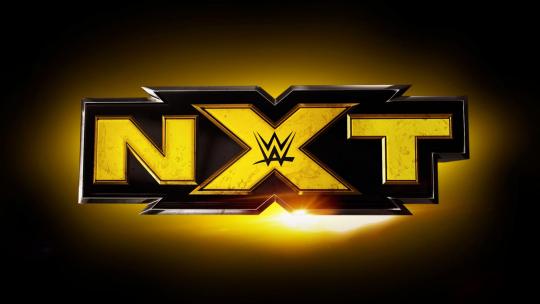
I am, if nothing else, always willing to test my hypotheses via data, so let’s take a look at every NXT call up since I started watching the WWE network (February, 2014). This does not include the FCW call ups, because that was before I started watching, but they are, all in all, a pretty spectacular group. IMPORTANT: I am grading the main roster tenures of the Superstars(tm), not them as individuals. For example, I think Neville is great and hope he tears it up on the indies (although please don’t let him go back to calling himself PAC), but it’s hard to see his time on the main roster as anything but, ultimately, a dud.
Paige
Call-up date: April 7, 2014. She debuted spectacularly, and then kind of hit a plateau where they didn’t know what to do with her. She kind of shared a gimmick with AJ Lee (”the anti diva”), flopped from heel to face with no real direction, was absent for a long time because of injuries and Alberto del Rio, and came back only to get a career-ending injury. I actually think she’s grown into her role as GM; this might be my favorite incarnation of WWE Paige. At best, though, this is a partial success, and clearly not what they had in mind for her future.
Grade: C
Rusev
Call-up date: April 7, 2014. Rusev has done pretty much exactly as well as I expected, spending time as a reliable mid-card presence with occasional breakout moments (his feud with John Cena, this “Rusev Day” thing that feels like it will never end). I enjoy his matches, he’s used well, the crowd responds to him. There’s nothing wrong with being a credible midcarder. Not everyone can be in the main event.
Grade: B+/A-
Lana
Call-up date: April 7. 2014. The former FSU Cowgirl was initially one of the best things about WWE TV, playing the icy Russian blonde to perfection. Vince hates managers, though, so it was determined that her Character Must Develop, and it did, disastrously. Remember the denim-clad Dolph Ziggler alliance? Remember the Dancing Lana vignettes? She still accompanies Rusev at times, but they’re now trying to make her a wrestler, and this is not really what she does best. She doesn’t even always remember to speak with the accent anymore. Without Rusev, she would have gone the way of Summer Rae long ago.
Grade: C-
Adam Rose
Call-up date: May 5, 2014. God, they bungled his arrival, but how over could he realistically expect to get with a kind of Russell Brand gimmick? He was all entrance in that character. Also, Personal Demons doomed his WWE run.
Grade: F
Bo Dallas
Call-up date: May 23, 2014. A fantastic heel champion in NXT, Dallas has been lost on the main roster. He’s a great example of a phenomenon we’ve seen repeatedly: a subtle, engaging gimmick that works in NXT (in his case, eerily motivational weirdo who is secretly a psycho) evaporating on contact with the WWE’s mass audience and hamfisted creative team. He’s only recently gotten anything resembling a push, which they’ve spoiled by rushing the B Team’s redemption story.
Grade: C-
The Ascension
Call-up date: September 9, 2014. A formative experience for me: being mystified as to why these Road Warriors knockoffs were so hugely popular with the Full Sail massive. Whereas Bo Dallas’ NXT gimmick could have worked with a better creative team, it seemed clear to me these guys were always going to be local heroes. They’ve vanished completely; it’s incredible they’re still on the roster.
Grade: F
Kalisto
Call-up date: February 27, 2015. The Man Who Would Be Rey has managed a respectable career on the lower midcard, racking up two U.S. title victories, which is kind of like the WWE’s version of a perfect attendance trophy. He’s found new life on 205 Live, to the extent that matters. He’s done about as well as a masked luchador not named Rey Misterio is going to do in Vince’s company.
Grade: C
Neville
Call-up date: March 30, 2015. Now Available For Indie Dates. He was a terrific fighting babyface champ in NXT, and was saddled with a fucking cape as soon as he came up to the main roster, a sure sign the creative team didn’t know what to do with him. He helped revive 205 Live from its initial doldrums, but then Problems With the Office ensured his stay in Vincetopia would be short. Despite his talent and popularity with hardcore fans, it’s hard to judge his tenure as anything other than a missed opportunity.
Grade: F
Kevin Owens
Call-up date: May 18, 2015. The first guy to get called up from the triple A club since Seth Rollins who was also a holy-shit big deal in the indies, Owens was initially handled so well, beating John Cena in his debut main roster match and coming off like the prizefighter that made him a star. In that crazy, heady time of 2015, I actually saw people wearing Kevin Owens shirts outside the context of wrestling shows, and it seemed like they had a breakout star on their hands. It did not work out that way! Although he’s had some stellar moments since then (the disintegration of his friendship with Jericho was a legitimately great angle), he’s settled into being the whiny pussy on the upper midcard who can occasionally be slotted into holding pattern feuds with babyfaces they’re priming for the top spots. He still does everything really well, and has his fans, but it’s hard not to imagine what could have been. I don’t see anyone wearing Kevin Owens shirts outside wrestling shows anymore, that’s for sure.
Grade: B-
Sasha Banks
Call-up date: July 13, 2015. She seemed like the odds-on favorite to be the breakout star from NXT’s women’s division, and although she’s been intermittently used well and has a high level of popularity, the stop-start booking, blink-and-you’ll-miss-it title reigns, and the inexplicable decision to make her mostly a vanilla babyface have dimmed her star a little. There are a lot more chapters to be written in her career, though, barring injury.
Grade: B+
Charlotte Flair
Call-up date: July 13, 2015. An undeniable star, they’ve built the women’s division of the main roster around her, and although she absolutely belongs at the top of the card, the push still feels a little ersatz. She’s good in the ring, but not the best, and her promos are passable, but she doesn’t have Alexa Bliss’ off-the-charts charisma. She’s less Ric Flair than she is Bob Backlund (early ‘80s version), which is not a terrible thing. I don’t know why the people who complain about Roman Reigns being overpushed don’t feel the same way about Charlotte.
Grade: A-
Becky Lynch
Call-up date: July 13, 2015. After initially being stuck in NXT with a hideously bad Riverdance gimmick, she became a fan favorite thanks to her charisma and wrestling chops. Along with Sasha and Charlotte, she spearheaded the “Women’s Revolution,” became the first-ever Smackdown Women’s champion, and then ... well, not much. Stuck in a succession of pointless midcard feuds, marooned with a gimmick that made her seem like she had a mild brain disorder (DO YOU LIKE PUNS?), she was treading water until her recent “heel turn” that is really a babyface turn.
Grade: B-/C+
Braun Strowman
Call-up date: August 24, 2015. BRAUUUUUUUN. As tired I am of his vaguely one-dimensional shtick, there’s no denying how insanely popular he is with the main roster crowd. He’s not only got a great look as a big guy, he’s also a surprisingly capable athlete who plays his character well. Even the WWE creative team could not screw this one up. He may never cross over to mainstream notoriety, but he could potentially slot into the Kane or even the Undertaker role, although Strowman’s gimmick would need a little spicing up for that.
Grade: A+
Tyler Breeze
Call-up date: October 22, 2015. In the late fall of 2014, I saw Tyler Breeze vs. Neville at a WWE house show in Springfield, Mass., and the crowd went from total indifference in the presence of these unknowns to ferociously hating Breeze within about five minutes. I said then, “This dude is an undeniable star. He is going to be absolutely huge.” I AM NEVER WRONG. No, of course he didn’t become a star. The main roster creative team took one of the most reliable heel gimmicks in wrestling (Tyler Breeze is, essentially, Gorgeous George) and somehow managed to make people feel total indifference to it. He was saved from Ascension-esque oblivion only by the Fashion Police skits, which Vince reportedly loved. But where do you go from there? Don Muraco main-evented a trio of Madison Square Garden matches against Hulk Hogan near the white-hot zenith of Hulkamania, and then, after the “Fuji Vice” and “Fuji General” comedy skits, was jobbing to Dino Bravo at SummerSlam. Tyler Breeze has so much talent, but I imagine we’ll get to see the full range of it during an indies-and-Japan sprint.
Grade: D+
That’s it for now! Tune in eventually for the Class of 2016.
5 notes
·
View notes
Photo

Meanwhile, some observations from last weekend's Character Convocation over the Wo-Zha-Wa weekend in Wisconsin Dells
In view of the need to avoid the crowds tending to arrive on Friday afternoon and evening, the hosts--Snagglepuss, Huckleberry Hound and Crazy Claws--decided it best to start the proceedings on Thursday afternoon, beginning with the traditional registration and opening addresses as saw much in the way of Hanna-Barberian friendships coming around and recognised. Not to mention much in the way of coffee, tea and spiced apple cider being offered early arrivals.
Once five in the afternoon got around, Huckleberry Hound offered in his welcoming remarks:
Seeing as we're here for as much Wo-Zha-Wa weekend as a character convocation, I felt it best, for the sake of avoiding possible chaos and confusion with the early arrivals on Friday, to begin this afternoon. Not to mention point out that, in view of what amounts to a rather compressed schedule on Saturday and Sunday especially, we've decided to scrap the symposiae and emphasise more of a "meet-and-greet" approach with festival goers across downtown Wisconsin Dells, where the festivities are being concentrated, throughout.
Which Snagglepuss "himself" seconded thus:
No doubt about it: We think this new approach of emphasising more of a "meet-and-greet" take on things, with requests for autographs, selfies even--and even some informal conversation among fellow fans otherwise here for what the Ho-Chunk peoples of these parts of Wisconsin call "a fun time"--and I am sure it will BE that, mind you, will make things more interesting. Especially when they're reminded of choicest moments from younger days in their Saturday-morning presence. Never mind its being at The Keg or at the Sand Bar or even MACS ... or walking down Broadway, even ... I certainly hope much memories (and much conversation) will be made throughout.
The outright host of this particular Convocation, Crazy Claws, offered up these insights:
Just imagine, a crazy wildcat like myself finding himself in such a crazy place as Wisconsin Dells is for no apparent reason other than his being, in the Cattanooga Cats' immortal words, "up, down and on the ground" for no reason of his choosing ... and eventually managing to get a gig on those legendary Wisconsin Ducks, whose narration is said to be the stuff of legend and fit my somewhat convoluted style. Especially when "crossing the bar" heading into Dell Creek and throwing in a pitch to "Get Marooned at the Sand Bar" for the sake of wordplay and comedy.
Which became enough, mind you, for yours truly to settle down and make my own Hanna-Barberian self known should it happen that any fellow characters like yourselves come this way and want to truly discover this swingin' town. I acknowledge that many of you have come over this way, whether you liked it or not, and I acknowledge that we've had many wonderful experiences. Such as the time I was able to get an overnight jam session for The Banana Splits handled out of nowhere, and over the burgers at Monk's Bar, and believe you me, the whole couldn't have been crazier!
Or even when Undercover Elephant and Loudmouse decided to do some chunky-dunking--that's skinny-dipping for the fatter crowd--out at Bare Arse Beach below the Sugar Bowl in the Lower Dells on a muggy summer's afternoon.
Or the Hair Bear Bunch sharing some fried chicken from the Maurer's Market delicatessen ahead of some serious overnight swimming at an otherwise abandoned beach on Lake Delton, not managing to wake the tourists sleeping in nearby summer rentals; I assume you all remember it well....
I admit there's too many to remember, but I assume we've likely crossed paths here at least once. Even when the Skatebirds were doing some inline antics on the Riverwalk there....
And having the opportunity to join Huck and Snagglepuss in hosting such wonderful get-togethers for our crowd here at the Wo-Zha-Wa weekend has got to be in itself an interesting experience. Even if it took awhile just having to find the ideal selection of cheeses and sausages, let alone crackers, for the snack bar following (and may I just thank Kwicky Koala for his contributing such Australian crackers as Jatz and SAO to the snacking table, as if more conventional snack crackers weren't quite good enough--even the English Table Water such--for some of Wisconsin's finest).
Prompting Snagglepuss to remind all that the cheeses and sausages were nothing but such from among Wisconsin's finest, including some exceptional Landjager, a German hunter's sausage, and venison summer sausage--which Crazy Claws helped picked out, never mind the Market Square Cheese shop being tacky-looking and Carr Valley Cheese's such downtown actually being serious in a way, without having any sort of a factory shop look. As well as including some Sprecher's craft sodas, including root beer, orange, honey cream, blackberry and Puma Kola.
I can only say that the cheese-and-crackers table was never wanting, and that for some reason, the Puma Kola actually turned out being unusually popular. Not to mention schedules of the rounds being expected to be made, as well as parade appearences on Sunday.
*************
Friday morning: In spite of a light misty rain and fog, a special breakfast run of the Dells Boat Tours' flagship Upper Dells excursion vessel, the Clipper Winnebago, was arranged for, including complementary donuts, danish, cinnamon rolls, coffee, tea--and as a concession to one "Shaggy" Rogers, Pero, a grain-based coffee-ersatz gaining some attention stateside. (Turns out a few others decided to try out the Pero for novelty's sake, many such dismissing it as tasting a little too grainy for their own tastes although Penelope Pitstop, by her own admission, managed to approve of it.) The two stops of Witch's Gulch and Stand Rock were made, with the latter featuring Crazy Claws attempting the famous jump (yet barely, remarking upon return that "so much for taking a stand for Stand Rock, let alone making the jump from a standing position. Or more like an outstanding position, come to think of it").
And considering that the first of fall's colour were becoming evident, such couldn't fail to attract the interest and attention all the more of anyone and everyone on board. Not to mention the complement of hot coffee and fresh donuts.
Meanwhile, over at the Tommy Bartlett Exploratory ... another classic Tom and Jerry chase ensued around a certain exhibit aimed at demonstrating how difficult it can be to lift a 2.5 ton minivan with a simple rope, which had Tom attempt to give Jerry a difficult time with the platform ... only to have Tom hit his head over the beam, immobilising him for a time. Ironically, across the way-ho-way. Motormouse couldn't resist a convenience-store microwave beef-and-bean burrito ahead of a run (inevitably to be followed by Autocat) out into the Sauk County countryside around the Dells and Baraboo, even out into Devil's Lake and Reedsburg.
As midday faded into the afterlunch, with some of the first Wo-Zha-Wa weekend traffic ensuing, it seemed you couldn't resist many a Hanna-Barbera Funtastic out and about along Broadway, dividing their time between mingling among the tourists and browsing the tacky shops throughout (and in the case of many, not resisting the samples of the candy kitchens). We understand one tourist caught The Banana Splits in an "escape room" scenario as managed to be resolved rather quicky thanks to Snorky hiding in his trunk a lock pick, followed by some soup-and-sandwich time at Great Harvest Bread as included plenty of conversations with some from Milwaukee and Chicago over wholemeal bread done in delicatessen style.
*************
Unlikely Quote: Inch High, Private Eye to as unlikely a character as Crazy Claws: "So who exactly IS this 'Kenosha Kid' I heard might be trying to pull an appearence here?"
Yahooey, of those Goofy Guards, within earshot all the while: "Bet you never did the Kenosha Kid!"
Crazy Claws, rejoindering: "Whoever HE is ... anyhow, I assume he's having a Swig With Nig."
*************
As unlikely a Friday-night distraction as it could get:
Over at the Showboat Saloon (”Get Nuts At--”), Friday night saw a rather crazy “drum wars” exercise between The Banana Splits’ Bingo and the Cattanooga Cats’ Groove. Admittedly, the Showboat’s performance space may have been rather smoky-looking and the floor littered with peanut shells and skins, but the crowds (raucous as they were in a scenario such as this) couldn’t resist eating it all up as Bingo and Groove battled their way through every known exercise in rock-band drum technique, including the storied “rimshot.”
When it was all over, roughly around 12:30 in the morning (by which time things were bound to get rather absurdly silly), it was decided to declare the match a draw as no clear winner was bound to emerge. Settled, at any rate, by bottles of Sprecher’s Cream Soda as much as the legendary in-shell peanuts--and requests for “selfies” and autographs from lapsed-in-memory fans.
*************
And for a modestly pleasant early-fall Friday evening such as seems rare during Wo-Zha-Wa, there could be no doubt that practically all those in attendance couldn't resist the sensation of encountering such who probably recalled their Saturday-morning television being thus enlightened. Even if Wally Gator, on seeing alligator jerky being offered at the Loon Lake Cigar Company's premi, was overheard responding "Who said alligators were getting rather jerky themselves without benefit of a few beers?"
Don't go away ... there's more of this to come next week in this space!
#fanfic friday#hanna barbera#wisconsin dells#character#conv#convocation#snagglepuss#huckleberry hound#crazy claws#upper dells boat tour#clipper winnebago#wo zha wa#meet and greet#fall festival
1 note
·
View note
Video
youtube
Https://www.raeuchermischung-24.de
#legal kiffen#legale kräutermischungen#legal thc#legal joint#legal herbs#legahighs#legal Highs#legale Räuchermischungen#raeuchermischung#kräutermischungen#spice#spice ersatz#bonzai
0 notes
Text
i recently realized my oven has a broiler so i marinated some chicken in yoghurt and spices and im using it as an ersatz tandoor
2 notes
·
View notes
Text
Fake Meat Alone Won’t Save the World
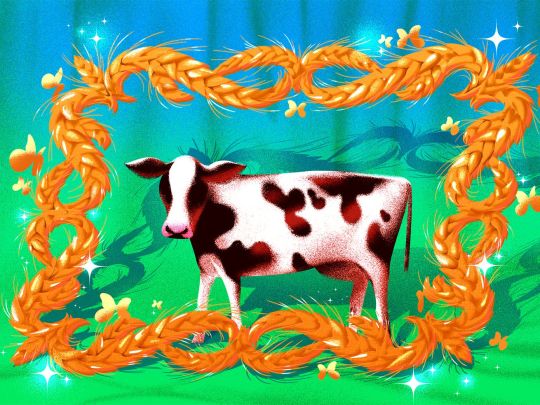
Not as long as factory farming is still a part of the food supply chain, anyway
In the middle of July, Impossible: The Cookbook, a compendium of recipes designed to showcase the plant-based meat engineered by Impossible Foods, was launched with grimly impeccable timing: Four months into the COVID-19 pandemic, meat shortages and revelations about the terrible conditions in meat processing facilities, where the virus had infected more than 25,000 workers nationwide, had cast an unforgiving light on the country’s industrial meat industry.
Impossible insists there is a better, highly versatile alternative to meat consumption, embodied in recipes like Kwame Onwuachi’s Ethiopian spiced meat with hummus and toasted cashews, where crumbled Impossible Burger takes the place of more traditional ground lamb. It is one of 40 recipes from a slew of well-respected chefs that demonstrate that the only limitation to what you can do with Impossible’s faux flesh is your own imagination.

The word “vegan” is conspicuously absent from the cookbook’s introduction, which instead proclaims that the book is “for people who love meat.” This is the kind of crafty messaging that has defined Impossible since July 2016, when the company launched its signature “bleeding” ersatz beef patty: This may be vegan meat, but it is designed to appeal to actual meat eaters. It’s clearly working: By early May of this year, sales of its products had shot up 264 percent since March.
The Impossible Foods story has been told many, many times since the company launched in 2011. It’s become a juggernaut with almost $1.5 billion in funding, a grocery store footprint that is 30 times larger than it was six months ago, and like any good tech unicorn, a proper direct-to-consumer website. Given Impossible’s projected growth, expanding product line (Impossible sausage was introduced in June), and compelling pitch (“We’re making meat,” the cookbook reads, “mouthwatering, craveable, nutritious meat — from plants” that “requires 87 percent less water and 96 percent less land to produce” than a conventional burger), it is tempting to think that plant-based meat is the way of the future. Impossible: The Cookbook suggests that it is not merely a possibility, but an inevitability, the only direction in which progress points. Impossible Foods CEO Pat Brown implied as much in an interview last year. “We are dead serious,” he said, “about our mission to eliminate the need for animals in the food chain by 2035.”
With a subtitle proclaiming “How to Save Our Planet, One Delicious Meal at a Time,” the cookbook — and, by extension, Impossible Foods — is promising no less than a brighter tomorrow that will be built upon patties wrought of soy and potato protein, disgorged on an endless assembly line monitored by contented, fairly compensated workers as happy cows roam on distant fields, free to live out their natural lives.
The strongest case for the vegan supply chain can be made by considering not what it is, but what it isn’t. The vegan supply chain isn’t factory farms, industrial livestock operations that house thousands of animals under one roof, often in miserable conditions that are not only inhumane but also terrible for the environment. Among other things, these farms generate about 70 percent of the country’s ammonia emissions and 14.5 percent of the world’s greenhouse gas emissions, contribute to deforestation, and create lagoons of animal waste that pollute the environment and sicken people in surrounding communities. The vegan supply chain also isn’t slaughterhouses or meat processing plants, where low-paid, often immigrant workers toil shoulder-to-shoulder in physically grueling conditions ripe for spreading COVID-19. And, although this should be obvious, the vegan supply chain is not one built upon abject animal suffering and exploitation.
Compared to that, the vegan supply chain looks pretty good, and Impossible Foods is hardly the only voice arguing that going vegan can save the planet. In 2018, the journal Science published the results of a comprehensive analysis of the environmental impact of 40,000 farms in 119 countries. It found that while meat and dairy supplied just 18 percent of food calories and 37 percent of protein, they used 83 percent of farmland — and produced 60 percent of agricultural greenhouse gas emissions. The upshot, as the study’s lead researcher told the Guardian, was that a “vegan diet is probably the single biggest way to reduce your impact on planet Earth, not just greenhouse gases, but global acidification, eutrophication, land use, and water use.” And last year, a report by the United Nations body on climate science concluded that reducing meat consumption in favor of plant-based diets could have a significant positive impact on our ability to fight climate change.
The vegan supply chain is not necessarily the One Weird Trick for solving all of our environmental and moral problems.
But while there is very little doubt that eating less meat and dairy is better for humanity’s chances of long-term survival in our current home, the vegan supply chain on its own is not necessarily the One Weird Trick for solving all of our environmental and moral problems. Like any agricultural supply chain, it is not automatically virtuous, much less neutral in its environmental impact. To examine some of the issues surrounding the vegan supply chain is to understand why a truly sustainable and ethical food supply chain is defined by more than simply what it is not. It is also to acknowledge that reforming the way we grow our food requires a truly systemic approach.
Even if we do accept that fake meat is the way of the more enlightened future, we still have to ask where, how, and by whom each of its ingredients is being grown and then processed, how the factory where it’s being mass-produced is being powered and how much greenhouse gas emissions it produces, and how much greenhouse gas is in turn produced by the different operations that supply the fake meat’s various ingredients, and packaging, and on and on forever more. Every step of the industrial supply chain — vegan or not — is fraught with these considerations, as well as more vexing questions than encouraging answers.
Take, for example, the soybean, a crop whose byproducts are ubiquitous ingredients in processed foods, both vegan and otherwise. The vast majority of the world’s soy — over 70 percent — is grown for livestock feed, which is why the growing demand for meat, particularly in China, has helped to double global soy production in the past two decades. It is soy grown for livestock feed, not vegan foods, that is a driver of deforestation in South America and its concomitant displacement of Indigenous communities and small farmers.
While only a tiny percentage of soy grown worldwide is for human consumption, the presence of soy in many vegan processed foods means that it is still necessary to ask where that soy comes from, and to question the practices used to grow it. Impossible Foods itself has been criticized for its use of soy, specifically the genetically modified soy in its burger. A host of controversies surrounds GMO soy, but Impossible Foods has defended its GMO ingredients by pointing out that its use of genetically modified soy is more environmentally sustainable than harvesting non-GMO soy, and, moreover, is safe for human consumption.
Along with soy, palm oil and cashews are ingredients that regularly appear in many vegan foods. Increasing demand for both presents a conundrum for anyone concerned about sustainable eating. Palm oil shows up in about 50 percent of consumer goods, including processed vegan foods like margarine, cookies, and ice cream. Palm oil plantations have been linked to numerous environmental and human rights issues, such as biodiversity loss and deforestation, and human rights abuses in Thailand and Indonesia.
The cashew, a foundational ingredient in many vegan dairy products, has been linked to human rights violations in Vietnam, the world’s leading cashew exporter. While some of the more egregious practices, such as the use of forced labor at processing facilities, have been curbed, the difficulties of tracking the cashew supply chain (cashews are often grown in one country, processed in another) mean that it’s possible for worker abuses, such as poverty-line wages and the use of child labor, to go undetected. And the cashew isn’t the only nut with issues: Almond production, for example, requires huge amounts of water, a problem exacerbated by the surging market for almond milk products.
In other words, no matter the crop being grown, there is the persistent issue of how farm laborers and the land they work are mistreated: Whether it is agricultural slavery on Florida tomato farms or illegal deforestation driven by Mexico’s growing avocado trade — which has also attracted the involvement and attendant violence of organized crime — the produce industry is rife with its own exploitative and abusive practices. And that doesn’t even begin to touch on the greenhouse gas emissions produced by plant-based agriculture, whether from artificial fertilizers or practices such as tilling the fields or the transport of produce around the globe.
To look at an Impossible Burger, or any industrial food, is to see a myriad of potentially troublesome links in the supply chain. Which is not to say that it’s impossible, so to speak, to have an ethical and sustainable supply chain. But the demands of capitalism — specifically that for food produced cheaply and at great volume in order to yield a profit — frequently undermine that goal. It’s a challenge that is further compounded by the imperative to feed a growing global population, and the varying standards for what it actually means to be ethical and sustainable at every level of the supply chain, vegan or not. Although switching to plant-based meat offers numerous environmental benefits, the companies that make it must find a way to reconcile the need to scale and make money with the practice of how to do so responsibly.
Even if the Impossible promise turns out to be true, that we can indeed have a perfectly virtuous vegan supply chain engineered by a hegemonic tech company, there is still one inconvenient fact: For any number of reasons — whether cultural or economic — the majority of people on the planet prefer to eat meat and will not give it up willingly, and that will remain the case perhaps even after plant-based meat is a truly perfect simulacrum of the real thing.
There are emerging alternatives. While they aren’t vegan, they do have the potential to accomplish the same goals as plant-based meat, perhaps some even more successfully. The need to create more sustainable alternatives to meat, combined with the preference of many people to continue eating it, has created a potentially lucrative opening for the cell-based, or cultured meat industry, whose inherent promise is meat without all of its accompanying demons. The industry began to get attention in 2013, when a Maastricht University professor named Mark Post successfully made a burger from cow stem cells he had grown into strips of muscle fiber. Since then, a number of cultured meat startups have popped up around the world, growing everything from meatballs to gelatin to seafood. Some observers are bullish about the industry’s potential: Last year, the consulting firm Kearney released a report predicting that by 2040, 60 percent of the world’s meat will be lab-grown or plant-based.
The least terrible option for meat eaters is to support farms that raise animals using sustainable and humane practices.
Cultured meat offers many potential advantages over both conventional and vegan meat, sustainability-wise: Whereas similar ingredients are used to produce both conventional and vegan meat (i.e. soy, potatoes, wheat, and water), cultured meat needs only a diet consisting predominantly of amino acids and glucose — ingredients grown in labs, rather than in resource-intensive fields.
The challenge, though, is producing it at scale, and doing so affordably; according to the Kearney report, the cost of cultured meat was $80 per 100 grams in 2018, versus conventional beef’s 80 cents per 100 grams (a number that reflects the way the industrial meat industry benefits from cheap grain, cheap labor, and direct and indirect government subsidies). While industry experts forecast that cost will be cut to less than $4 per 100 grams in the next 12 years, there are still plenty of hurdles to overcome, such as regulatory approvals and consumer acceptance.
Cultured meat may indeed be one way toward a more environmentally sustainable future, but that future remains relatively distant and highly speculative. For now, perhaps the least terrible option for recalcitrant meat eaters who care about the environment and have the privilege of choice is to support the small, independent farms that raise animals using sustainable and humane practices. Nearly 100 percent of most livestock raised for consumption lives on factory farms. There’s little doubt that small farms can be a more sustainable alternative — one that should be combined with an even more sustainable alternative, which is just to eat less meat. Decreased consumption leads to decreased demand and, in turn, to decreased production. But given that global meat production is projected to be 16 percent higher in 2025 than it was a decade prior, this seems as unrealistic as the likelihood of McDonald’s rolling out cell-cultured Big Macs in time for Christmas.
Rather than looking at the sustainable food supply chain of the future as an all-or-nothing scenario — one that either involves animal products or doesn’t — it’s perhaps more practical to take a holistic view, one that acknowledges the dizzying complexities of food production, as well as the varying definitions and measures of “sustainability.” Put another way, there is no single correct approach to fixing our problems, something illustrated by a 2017 study about the potential of organic agriculture to create a more sustainable food system. A 100 percent conversion to organic agriculture wouldn’t do it, the study found — among other problems, organic farming would require more farmland than its conventional counterpart. A more sustainable scenario, the study concluded, would combine organic agriculture with reductions in food waste and the amount of food used for livestock, along with a corresponding reduction in the production and consumption of meat.
Even supposing there is no magic bullet, there does seem to be one obvious thing we could do to build a more sustainable supply chain: stop factory farming. Because while livestock farming can be sustainable and even ethical, particularly if it’s done on a smaller scale and using practices that favor the environment and human and animal welfare, there is nothing sustainable about the industrial livestock industry. And if climate change, environmental degradation, and worker and animal abuses haven’t given us reasons enough to find a better way forward, then the COVID-19 pandemic has provided yet another compelling reason by highlighting the ways that factory farms, with their overcrowded, unsanitary conditions ripe for spreading disease and promoting antibiotic resistance, may put us at risk for future pandemics.
The call to end factory farming is gaining momentum: Last December, Sen. Cory Booker introduced legislation that would place a moratorium on large industrial animal operations and phase out the biggest ones by 2040. Crucially, the proposed bill also calls for strengthening protections for the family farmers and ranchers who cannot compete with these large-scale operations and are often forced into exploitative contracts with the corporations that control the meat industry.
This kind of support for small, independent farmers is at the heart of what the ethical and sustainable supply chain of the future entails: It is not so much about vegan eating as it is about creating systems that enable farming that is humane for the environment, people, and animals. Plant-based meat can be part of that, and should be — provided that the companies that manufacture it are actively invested in creating a system whose concept of ethics and sustainability goes beyond being simply the lesser of two evils.
from Eater - All https://ift.tt/32O5Kn1 https://ift.tt/34UzD7W

Not as long as factory farming is still a part of the food supply chain, anyway
In the middle of July, Impossible: The Cookbook, a compendium of recipes designed to showcase the plant-based meat engineered by Impossible Foods, was launched with grimly impeccable timing: Four months into the COVID-19 pandemic, meat shortages and revelations about the terrible conditions in meat processing facilities, where the virus had infected more than 25,000 workers nationwide, had cast an unforgiving light on the country’s industrial meat industry.
Impossible insists there is a better, highly versatile alternative to meat consumption, embodied in recipes like Kwame Onwuachi’s Ethiopian spiced meat with hummus and toasted cashews, where crumbled Impossible Burger takes the place of more traditional ground lamb. It is one of 40 recipes from a slew of well-respected chefs that demonstrate that the only limitation to what you can do with Impossible’s faux flesh is your own imagination.

The word “vegan” is conspicuously absent from the cookbook’s introduction, which instead proclaims that the book is “for people who love meat.” This is the kind of crafty messaging that has defined Impossible since July 2016, when the company launched its signature “bleeding” ersatz beef patty: This may be vegan meat, but it is designed to appeal to actual meat eaters. It’s clearly working: By early May of this year, sales of its products had shot up 264 percent since March.
The Impossible Foods story has been told many, many times since the company launched in 2011. It’s become a juggernaut with almost $1.5 billion in funding, a grocery store footprint that is 30 times larger than it was six months ago, and like any good tech unicorn, a proper direct-to-consumer website. Given Impossible’s projected growth, expanding product line (Impossible sausage was introduced in June), and compelling pitch (“We’re making meat,” the cookbook reads, “mouthwatering, craveable, nutritious meat — from plants” that “requires 87 percent less water and 96 percent less land to produce” than a conventional burger), it is tempting to think that plant-based meat is the way of the future. Impossible: The Cookbook suggests that it is not merely a possibility, but an inevitability, the only direction in which progress points. Impossible Foods CEO Pat Brown implied as much in an interview last year. “We are dead serious,” he said, “about our mission to eliminate the need for animals in the food chain by 2035.”
With a subtitle proclaiming “How to Save Our Planet, One Delicious Meal at a Time,” the cookbook — and, by extension, Impossible Foods — is promising no less than a brighter tomorrow that will be built upon patties wrought of soy and potato protein, disgorged on an endless assembly line monitored by contented, fairly compensated workers as happy cows roam on distant fields, free to live out their natural lives.
The strongest case for the vegan supply chain can be made by considering not what it is, but what it isn’t. The vegan supply chain isn’t factory farms, industrial livestock operations that house thousands of animals under one roof, often in miserable conditions that are not only inhumane but also terrible for the environment. Among other things, these farms generate about 70 percent of the country’s ammonia emissions and 14.5 percent of the world’s greenhouse gas emissions, contribute to deforestation, and create lagoons of animal waste that pollute the environment and sicken people in surrounding communities. The vegan supply chain also isn’t slaughterhouses or meat processing plants, where low-paid, often immigrant workers toil shoulder-to-shoulder in physically grueling conditions ripe for spreading COVID-19. And, although this should be obvious, the vegan supply chain is not one built upon abject animal suffering and exploitation.
Compared to that, the vegan supply chain looks pretty good, and Impossible Foods is hardly the only voice arguing that going vegan can save the planet. In 2018, the journal Science published the results of a comprehensive analysis of the environmental impact of 40,000 farms in 119 countries. It found that while meat and dairy supplied just 18 percent of food calories and 37 percent of protein, they used 83 percent of farmland — and produced 60 percent of agricultural greenhouse gas emissions. The upshot, as the study’s lead researcher told the Guardian, was that a “vegan diet is probably the single biggest way to reduce your impact on planet Earth, not just greenhouse gases, but global acidification, eutrophication, land use, and water use.” And last year, a report by the United Nations body on climate science concluded that reducing meat consumption in favor of plant-based diets could have a significant positive impact on our ability to fight climate change.
The vegan supply chain is not necessarily the One Weird Trick for solving all of our environmental and moral problems.
But while there is very little doubt that eating less meat and dairy is better for humanity’s chances of long-term survival in our current home, the vegan supply chain on its own is not necessarily the One Weird Trick for solving all of our environmental and moral problems. Like any agricultural supply chain, it is not automatically virtuous, much less neutral in its environmental impact. To examine some of the issues surrounding the vegan supply chain is to understand why a truly sustainable and ethical food supply chain is defined by more than simply what it is not. It is also to acknowledge that reforming the way we grow our food requires a truly systemic approach.
Even if we do accept that fake meat is the way of the more enlightened future, we still have to ask where, how, and by whom each of its ingredients is being grown and then processed, how the factory where it’s being mass-produced is being powered and how much greenhouse gas emissions it produces, and how much greenhouse gas is in turn produced by the different operations that supply the fake meat’s various ingredients, and packaging, and on and on forever more. Every step of the industrial supply chain — vegan or not — is fraught with these considerations, as well as more vexing questions than encouraging answers.
Take, for example, the soybean, a crop whose byproducts are ubiquitous ingredients in processed foods, both vegan and otherwise. The vast majority of the world’s soy — over 70 percent — is grown for livestock feed, which is why the growing demand for meat, particularly in China, has helped to double global soy production in the past two decades. It is soy grown for livestock feed, not vegan foods, that is a driver of deforestation in South America and its concomitant displacement of Indigenous communities and small farmers.
While only a tiny percentage of soy grown worldwide is for human consumption, the presence of soy in many vegan processed foods means that it is still necessary to ask where that soy comes from, and to question the practices used to grow it. Impossible Foods itself has been criticized for its use of soy, specifically the genetically modified soy in its burger. A host of controversies surrounds GMO soy, but Impossible Foods has defended its GMO ingredients by pointing out that its use of genetically modified soy is more environmentally sustainable than harvesting non-GMO soy, and, moreover, is safe for human consumption.
Along with soy, palm oil and cashews are ingredients that regularly appear in many vegan foods. Increasing demand for both presents a conundrum for anyone concerned about sustainable eating. Palm oil shows up in about 50 percent of consumer goods, including processed vegan foods like margarine, cookies, and ice cream. Palm oil plantations have been linked to numerous environmental and human rights issues, such as biodiversity loss and deforestation, and human rights abuses in Thailand and Indonesia.
The cashew, a foundational ingredient in many vegan dairy products, has been linked to human rights violations in Vietnam, the world’s leading cashew exporter. While some of the more egregious practices, such as the use of forced labor at processing facilities, have been curbed, the difficulties of tracking the cashew supply chain (cashews are often grown in one country, processed in another) mean that it’s possible for worker abuses, such as poverty-line wages and the use of child labor, to go undetected. And the cashew isn’t the only nut with issues: Almond production, for example, requires huge amounts of water, a problem exacerbated by the surging market for almond milk products.
In other words, no matter the crop being grown, there is the persistent issue of how farm laborers and the land they work are mistreated: Whether it is agricultural slavery on Florida tomato farms or illegal deforestation driven by Mexico’s growing avocado trade — which has also attracted the involvement and attendant violence of organized crime — the produce industry is rife with its own exploitative and abusive practices. And that doesn’t even begin to touch on the greenhouse gas emissions produced by plant-based agriculture, whether from artificial fertilizers or practices such as tilling the fields or the transport of produce around the globe.
To look at an Impossible Burger, or any industrial food, is to see a myriad of potentially troublesome links in the supply chain. Which is not to say that it’s impossible, so to speak, to have an ethical and sustainable supply chain. But the demands of capitalism — specifically that for food produced cheaply and at great volume in order to yield a profit — frequently undermine that goal. It’s a challenge that is further compounded by the imperative to feed a growing global population, and the varying standards for what it actually means to be ethical and sustainable at every level of the supply chain, vegan or not. Although switching to plant-based meat offers numerous environmental benefits, the companies that make it must find a way to reconcile the need to scale and make money with the practice of how to do so responsibly.
Even if the Impossible promise turns out to be true, that we can indeed have a perfectly virtuous vegan supply chain engineered by a hegemonic tech company, there is still one inconvenient fact: For any number of reasons — whether cultural or economic — the majority of people on the planet prefer to eat meat and will not give it up willingly, and that will remain the case perhaps even after plant-based meat is a truly perfect simulacrum of the real thing.
There are emerging alternatives. While they aren’t vegan, they do have the potential to accomplish the same goals as plant-based meat, perhaps some even more successfully. The need to create more sustainable alternatives to meat, combined with the preference of many people to continue eating it, has created a potentially lucrative opening for the cell-based, or cultured meat industry, whose inherent promise is meat without all of its accompanying demons. The industry began to get attention in 2013, when a Maastricht University professor named Mark Post successfully made a burger from cow stem cells he had grown into strips of muscle fiber. Since then, a number of cultured meat startups have popped up around the world, growing everything from meatballs to gelatin to seafood. Some observers are bullish about the industry’s potential: Last year, the consulting firm Kearney released a report predicting that by 2040, 60 percent of the world’s meat will be lab-grown or plant-based.
The least terrible option for meat eaters is to support farms that raise animals using sustainable and humane practices.
Cultured meat offers many potential advantages over both conventional and vegan meat, sustainability-wise: Whereas similar ingredients are used to produce both conventional and vegan meat (i.e. soy, potatoes, wheat, and water), cultured meat needs only a diet consisting predominantly of amino acids and glucose — ingredients grown in labs, rather than in resource-intensive fields.
The challenge, though, is producing it at scale, and doing so affordably; according to the Kearney report, the cost of cultured meat was $80 per 100 grams in 2018, versus conventional beef’s 80 cents per 100 grams (a number that reflects the way the industrial meat industry benefits from cheap grain, cheap labor, and direct and indirect government subsidies). While industry experts forecast that cost will be cut to less than $4 per 100 grams in the next 12 years, there are still plenty of hurdles to overcome, such as regulatory approvals and consumer acceptance.
Cultured meat may indeed be one way toward a more environmentally sustainable future, but that future remains relatively distant and highly speculative. For now, perhaps the least terrible option for recalcitrant meat eaters who care about the environment and have the privilege of choice is to support the small, independent farms that raise animals using sustainable and humane practices. Nearly 100 percent of most livestock raised for consumption lives on factory farms. There’s little doubt that small farms can be a more sustainable alternative — one that should be combined with an even more sustainable alternative, which is just to eat less meat. Decreased consumption leads to decreased demand and, in turn, to decreased production. But given that global meat production is projected to be 16 percent higher in 2025 than it was a decade prior, this seems as unrealistic as the likelihood of McDonald’s rolling out cell-cultured Big Macs in time for Christmas.
Rather than looking at the sustainable food supply chain of the future as an all-or-nothing scenario — one that either involves animal products or doesn’t — it’s perhaps more practical to take a holistic view, one that acknowledges the dizzying complexities of food production, as well as the varying definitions and measures of “sustainability.” Put another way, there is no single correct approach to fixing our problems, something illustrated by a 2017 study about the potential of organic agriculture to create a more sustainable food system. A 100 percent conversion to organic agriculture wouldn’t do it, the study found — among other problems, organic farming would require more farmland than its conventional counterpart. A more sustainable scenario, the study concluded, would combine organic agriculture with reductions in food waste and the amount of food used for livestock, along with a corresponding reduction in the production and consumption of meat.
Even supposing there is no magic bullet, there does seem to be one obvious thing we could do to build a more sustainable supply chain: stop factory farming. Because while livestock farming can be sustainable and even ethical, particularly if it’s done on a smaller scale and using practices that favor the environment and human and animal welfare, there is nothing sustainable about the industrial livestock industry. And if climate change, environmental degradation, and worker and animal abuses haven’t given us reasons enough to find a better way forward, then the COVID-19 pandemic has provided yet another compelling reason by highlighting the ways that factory farms, with their overcrowded, unsanitary conditions ripe for spreading disease and promoting antibiotic resistance, may put us at risk for future pandemics.
The call to end factory farming is gaining momentum: Last December, Sen. Cory Booker introduced legislation that would place a moratorium on large industrial animal operations and phase out the biggest ones by 2040. Crucially, the proposed bill also calls for strengthening protections for the family farmers and ranchers who cannot compete with these large-scale operations and are often forced into exploitative contracts with the corporations that control the meat industry.
This kind of support for small, independent farmers is at the heart of what the ethical and sustainable supply chain of the future entails: It is not so much about vegan eating as it is about creating systems that enable farming that is humane for the environment, people, and animals. Plant-based meat can be part of that, and should be — provided that the companies that manufacture it are actively invested in creating a system whose concept of ethics and sustainability goes beyond being simply the lesser of two evils.
from Eater - All https://ift.tt/32O5Kn1 via Blogger https://ift.tt/2EE8njn
0 notes
Text
#KeepingUpWithKym
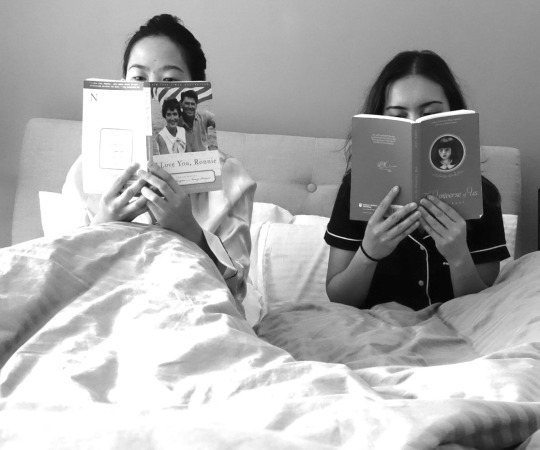
Who comes into my mind when I think of the phrase “partner-in-crime?” Definitely not Kym. Hahaha because honestly, the things we do when we’re together are as close to crime as Duterte is to being presidential. Basically we attend paint classes, watch musicals, bake cookies, comment on each other’s tumblr, and make loom bands with pediatric patients. If we had a reality show, we’d be the GeneralPatronage-rated version of Paris Hilton and Nicole Richie - we literally receive the middle finger from irate Italian drivers for slowing down to let them pass.

But it works, because sharing the exact same interest for grandma activities means we automatically know what each other wants to do when we hang out. (Also, look at us, how cute do we look in our matching pajamas hahahahaha effort tong mga pictures na to in fairness, photo credits to Kym’s camera stand lol.)
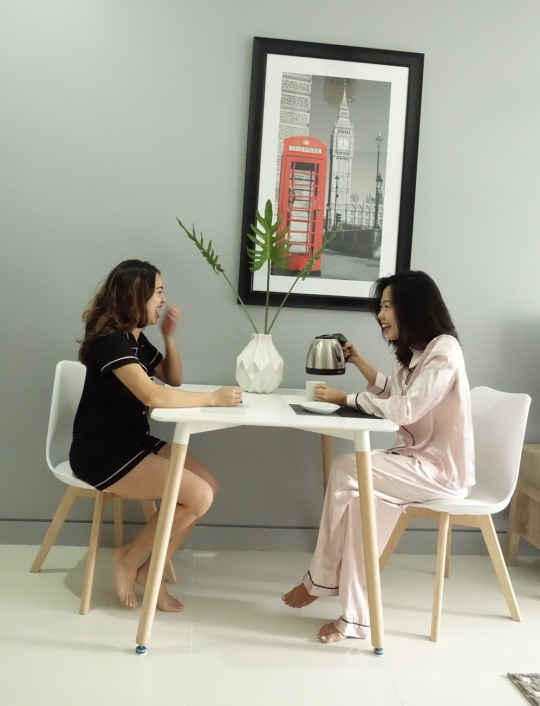
For example, this weekend. Kym had flown in from California to spend her vacation leave with her loved ones (ehem) in the Philippines. When she told me she had time in her schedule for a day together, I didn’t even have to think twice about our itinerary - stay in McKinley Hill for the night to drink tea and read books haha, have breakfast at the Venice Piazza Mall, and soak in some art at the Pinto Art Museum (we also wanted to try our hand at this archery place, but alas we ran out of time).

Good morniiiing.
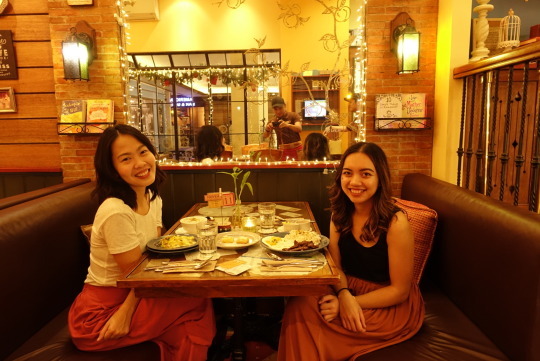
Breakfast at Mary Grace. Their mushroom cheese omelette and lemon squares are DIVINE.

Riding a gondola in the Manila version of Venice instead of actually going to Venice because the angry Italian drivers traumatized us lololol.


The Pinto Art Museum is my absolute favorite museum in the Philippines. The old Filipino/Greco aesthetic, the unique contemporary artwork by local artists, the huge windows and natural light, the open, intimate vibe of the place - ugh I seriously could stay here all day.
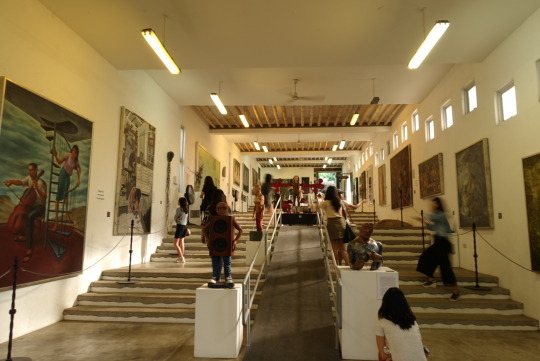
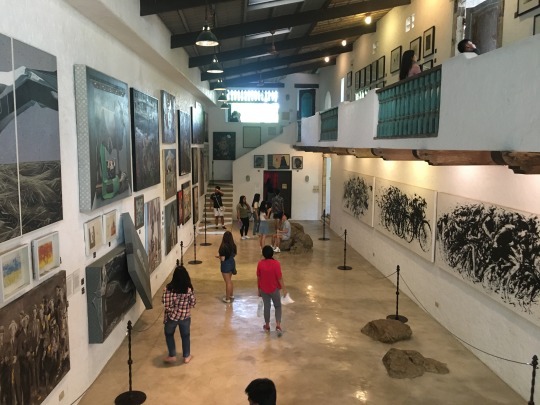
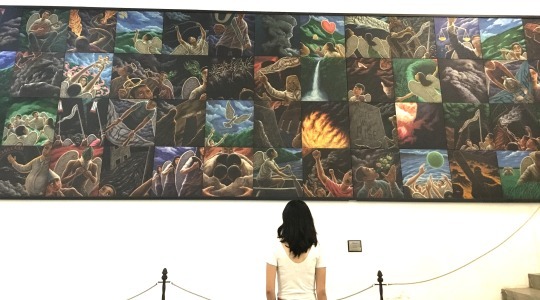

What I love most about the artwork at this museum is that they all reflect contemporary issues - poverty, inequity, colonial mentality, gender, urban life, politics - making the art so completely relatable and thought-provoking.
Here, let me try to show you a sampler of the art:

Oh wait, you mean like paintings and sculptures? HAHAHA yes sure the museum had those too. There were so many interesting pieces, but here are my favorites because well, they made me feel things:
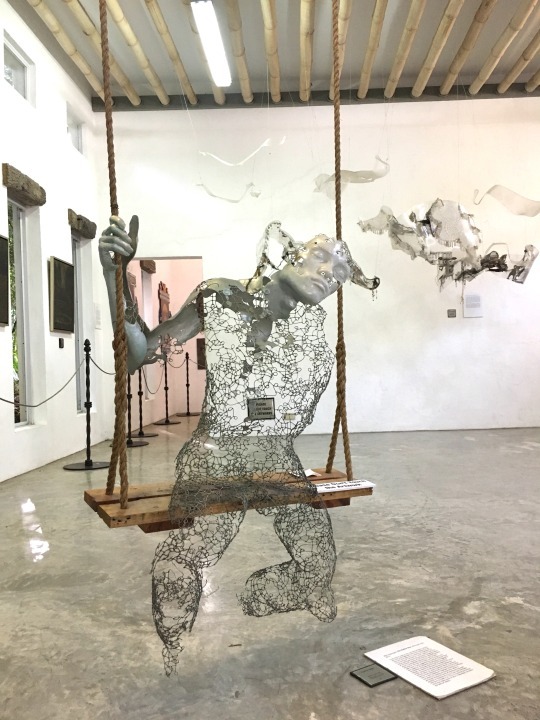
The Hollow Man Alab Pagarigan I dunno, I like calling this one Turning Invisible lol. My photograph isn’t too good, but at the right angle, it really looks like the figure is slowly turning invisible as he rocks back and forth on his swing.
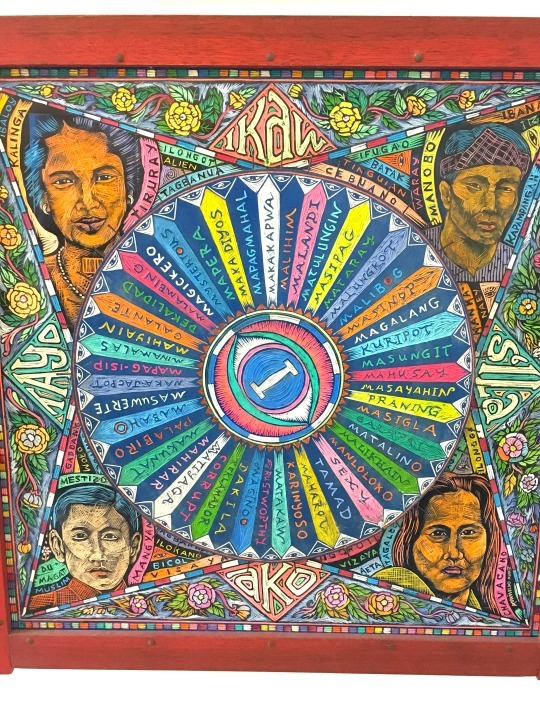
Roulette Leonard Aguinaldo The roulette is marked with various traits such as galante (generous), magalang (respectful), malandi (flirtatious), praning (paranoid). Around the roulette are the words ikaw (you), ako (I/me), sila (them), tayo (us). I guess this artwork spoke to me because it deals with the human tendency to define people by one specific trait, as if we all get one spin at the character roulette of life.



Manyika Elmer Borlongan The painting unfolds like a tense drama. At the edge of a railroad stands a middle-aged woman in a dress, her plumpness and vacant stare suggest a form of mental retardation. She seems to have been under care for so long, but what startles us is a mannequin leg of a man that she clutches like a doll. Is she lost? Where has she come from? Why is she here? And where did she get that leg?
Even in his early career in the 1990s, Borlongan has been drawn to observe and paint unusual street characters in the urban metropolis. These are people with idiosyncracies who, under the artist’s rendering, stand as monuments to the dissonance we encounter in the streets of Manila: armless guitar players, homeless children, blind men leading other blind men, and people swimming in reused oil drums, head first.
Manyika resonates this everyday strangeness. She is someone we can indeed encounter roaming some back street in Tondo, or Paco, or even in some remote edge of megapolitan Makati, holding the limbs of an amputated mannequin like a cherished toy. Is the leg an ersatz for a partner or a relationship that is too difficult for a person of her disability? Does it stand for a lover, perceived as real? Is this a personal fetish? Does it startle us to realize that even in mental regression, the desire for a connection is present? Manyika challenges our questions, engages our concept of humanness, of personal longing. It also addresses the difficult question of Otherness: Why does she look like an Other, in her strangeness?



Tinggang Baluti Salvador Alonday The subject of this bust sculpture is Superman. Look at his face and discover the little kiss of hair that is suggested across his forehead. But it is a Superman reimagined and reinterpreted in the manner of Christ as Sagrado Corazon, the Sacred Heart. Alonday merges the image of both heroes, tongue-in-cheek to create a cross commentary on the idea of redeemer and savior. After all, both heroes are not from this world, reared in the simple hearth-centered morality of farmers and workers, which in turn provides a check against their overwhelming powers: Superman with his brute strength and invincibility and Christ with His healing and ability to overcome death. This core of values lies beneath the shell of Alonday’s Superman - a heart that is both exposed and covered.
Alonda’s Superman is made to appear to be made of two metals, copper and lead. But the title refers to the possibility of Superman having a shell or outfit made of lead, the only thing that shields him from the radiation of Kryptonite. Thus with his tinggang baluti, Superman becomes truly invincible, invulnerable. He is rendered safe from weakness and death, and being so, he is able to expose his own heart. Does the artist imply that there is a need for an effective and powerful layer of protection before one can choose to be vulnerable? That even the most powerful of heroes need to wear a shell before choosing to be open to the manifestations of the heart? Alonday’s Superman casts his eyes downward in a glance of compassion. The work thus forges a wonderful sense of ambiguity, the paradox of power and love.

I don’t remember feeling this empty Joanna Helmut The painting is of an unusual visage: a young girl suffering from the throes of depression. I don’t remember feeling this empty is set in a bare blue room with an empty picture frame and a lone stool standing too close in a corner. Occupying almost two-thirds of the picture is a girl in a pink dress, with her one hand clasping her forehead in a gesture of culpability. The title of the piece could very well serve as her inner monologue and we are left to wonder why. What can cause such emptiness in the heart of a child so young? Joanna Helmut’s work derives its power not just from her carefully arranged elements and muted hues, but also in her courage to represent what the Filipino public once dismissed as taboo: the affliction of melancholy. The dismissal is one of non-acknowledgment, confident as we are that the time-honored structures of family and friendship could soothe any depression, which is misunderstood as sadness. Helmut’s emphasis on the condition of emptiness, that is the loss of vital meaning for living, is efficiently portrayed here and even strongly amplified in the subject of child sufferer. It is a work that requires the choice to observe and affirm that life is simply not a precession of values and generations, but also a cycle of vigor and shadow.
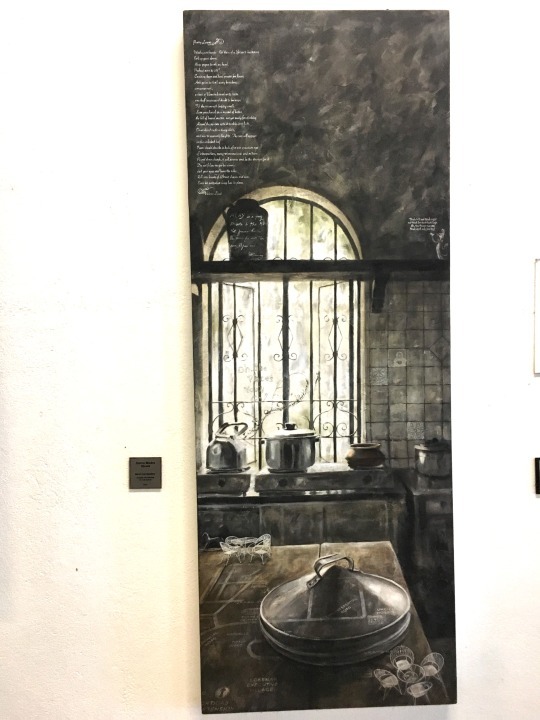
The script at the top left of this piece reads:
Poetry Loaves Wash your hands. Rid them of a lifetime’s hesitation. Roll up your sleeves. Keep paper towels on hand Preheat oven to 375. Combine flour and loud pauses for flavor Add spices to thrill away boredom: cinnamon risk, a dash of blanched candour to taste one-half teaspoon of doubt to balance. Fill the room with baking smells. Lose your hands in a mound of batter, the hill of bound matter, not yet ready for climbing. Knead the mixture until it tumbles into birth. Cover dough with a damp cloth, and rise to unseemly heights. The sun will appear in this unbaked loaf Poem should double in bulk after one uncertain age of introspection, many reincarnations and editions. Pound down dough, it will survive and be the stronger for it Do not follow recipe too closely: shut your eyes and burn the rules Roll into loaves of different shapes and sizes. Even an outspoken lump has its place.


Kasal sa Hatinggabi (Wedding at Midnight: The Church and the State) Elmer Borlongan, Karen Flores, Mark Justiniani, Joy Mallari, Federico Sievert This painting ridicules even as it exposes what hte artists perceive as a “testy and treacherous” alliance between Church and State. The scene is a parody of the rural wedding dance that often includes the release of doves hiding in a makeshift papier mache bell. The wedding couple: a politician and a cleric stand beneath this bell arch, at a dance that occurs curiously in the dead of the night, each with a weapon in one hand, while an arm seems to embrace the other. By showing them as marrying, even if in the most treacherous of arrangements, the artists declare openly that it is a match that is so ominous in their prospect for everyone. It is a painting of warning.
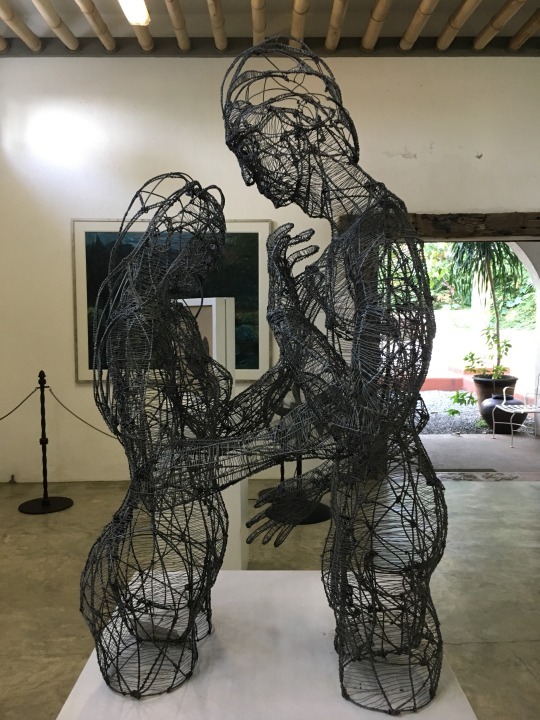
Oblivious Steph Lopez Two sculpted figures in wire approach each other in a tentative embrace. The taller male form stretches his right arm out to touch the female’s hip, while his left hand is bent back, reluctant. The more engaged female is inches away from a caress, her face focused on the moment of the touch, even as the male appears withdrawn, impassive, like a distant deity. The work hints at an incipient moment of intimacy, which somehow fails, and we are left seeing the gestures of affection that has either waxed or waned.

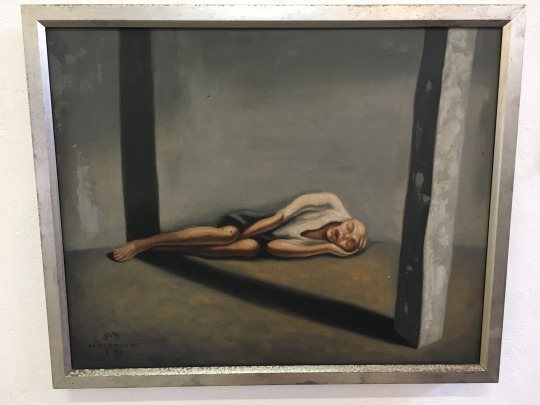
Kubli Elmer Borlongan With its face and bodily proportions stretched out like the figure of Edvard Munch’s The Scream, Elmer Borlongan’s painting of a child sleeping in a dimly-lit corner on a bare concrete floor possesses a foreboding drama that is rare in the artist’s oeuvre. The single source of light casts a long shadow of a post that runs across the feet of the dormant boy, like an ominous presence that watches over his slumber. Yet, with his palm as a pillow and the other nestled for warmth between his knees, our sleeper is unaware, almost dead to everything else in the world. It is the sleep of extreme exhaustion, from going through a day’s worth of work, or of endless meandering and seeking alms and food. It is the sleep of an animal that has run out of energy to scrounge and is content to find the darkest, most secure place it can find, as shelter.
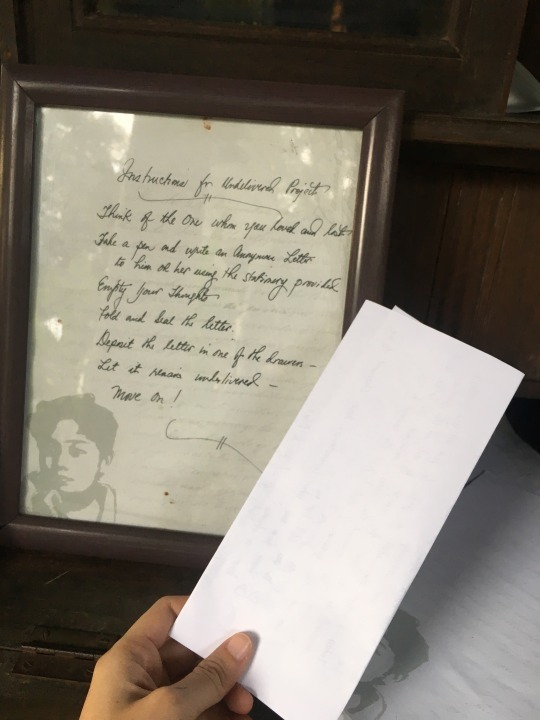
The Undelivered Project Think of the one whom you have loved and lost. Take a pen and write an anonymous letter to him or her using the stationery provided. Empty your thoughts. Fold and seal the letter. Deposit the letter in one of the drawers - Let it remain undelivered - Move on!

5 notes
·
View notes